Accessibility of Tram Services
Snapshot
Are tram services meeting the accessibility needs of passengers with mobility restrictions?
Why this audit is important
Melbourne’s tram network is a crucial public transport mode, with 205 million trips taken each year.
In Victoria, 17 per cent of the population lives with some form of disability.
The Disability Discrimination Act 1992 (DDA) requires that all tram stops must be fully compliant with the Disability Standards for Accessible Public Transport 2002 (DSAPT) by 31 December 2022 and all trams must be DSAPT compliant by 31 December 2032.
Notwithstanding these legislative requirements, a person with a mobility restriction cannot have, in any practical sense, an accessible tram journey without both a level-access stop and a low-floor tram.
Who we examined
- Department of Transport (DoT)
- Yarra Trams (YT), which operates the tram network through a franchise agreement with DoT.
What we examined
- DoT and YT’s progress on complying with tram accessibility requirements
- DoT and YT’s strategies, plans and programs to achieve compliance with the legislated disability standards.
What we concluded
Tram services are not meeting the accessibility needs of passengers with mobility restrictions.
In 2018–19, only 15 per cent of tram services delivered a low-floor tram at a level-access stop. DoT has not met legislated targets for accessible tram infrastructure and cannot comply by 31 December 2022. Based on the trend to date, DoT is also at risk of not meeting the 31 December 2032 tram compliance requirement.
DoT’s lack of a finalised strategy or a funded plan means it does not know when all tram services will be fully DDA and DSAPT compliant.
Noncompliance poses a financial risk for the state due to possible legal rulings against it for not meeting legislative requirements.
What we recommended
We made 10 recommendations to DoT aimed at improving their legislative compliance and their understanding of the accessible infrastructure gap and the costs and benefits of tram stop works. We also recommended better public information on tram accessibility and the need to link tram network planning to accessibility outcomes. All our recommendations were accepted.
Video presentation
Key facts
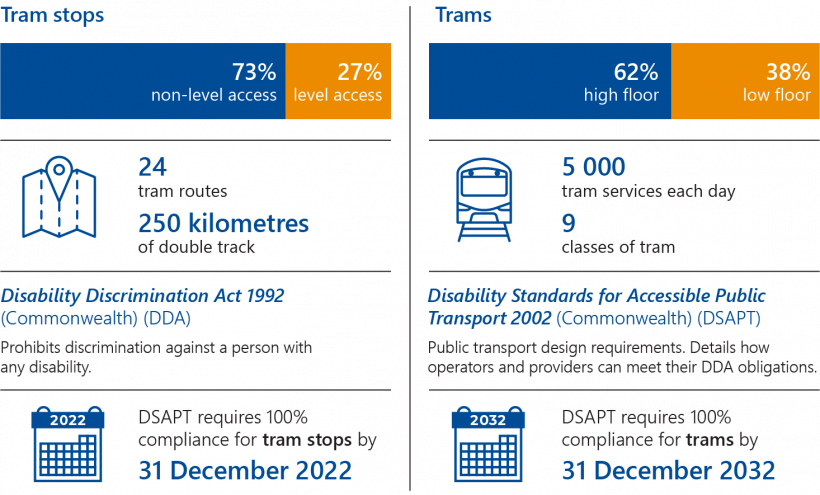
Interactive map
Click here to view the interactive map full screen.
What we found and recommend
We consulted with the audited agencies and considered their views when reaching our conclusions. The agencies’ full responses are in Appendix A.
Compliance with applicable laws
The Department of Transport has not met legislated accessibility targets
The Department of Transport (DoT) has not met the legislated targets to comply with the Disability Standards for Accessible Public Transport 2002 (DSAPT) for tram infrastructure and is unlikely to achieve full DSAPT compliance by 31 December 2022.
Failure to meet these targets is likely to breach relevant legislation. It also means that many people with mobility restrictions will continue to face practical and physical barriers when trying to access the tram network.
This puts DoT at risk of failing to fulfil its positive duty, required under the Victorian Equal Opportunity Act 2010 (EOA), to stop and remove discriminatory practices.
The temporary exemptions from the Australian Human Rights Commission (AHRC), previously held by Yarra Trams (YT), expired on 30 September 2020. This leaves DoT (and YT as its franchisee) at risk of breaching DSAPT and the Disability Discrimination Act 1992 (DDA).
This may expose DoT and YT to disability discrimination complaints (and as a result, financial risk) from affected individuals through either the AHRC under DDA, or the Victorian Equal Opportunity and Human Rights Commission (VEOHRC) under the EOA.
Tram network compliance data is not reliable
DoT does not know the full extent of its compliance with DSAPT because of limitations in the accuracy, completeness, and therefore reliability of its data. This is because of how DoT collects compliance data, gaps in what it measures, and functional limitations in the database where it stores the data. For example:
- The data in DoT’s database is incomplete because data only exists for DSAPT parts where an external reviewer has assessed those parts and DoT and YT have entered it in the system.
- DoT and YT have no reliable data about the number of DSAPT-compliant trams operating on the network. Having a low floor does not automatically make a tram DSAPT compliant.
FIGURE A: Compliance with DSAPT
| DSAPT final target | Extent of compliance | |
|---|---|---|
| Infrastructure | 100 per cent of tram stops by 31 December 2022 | DoT does not know this because of data limitations. DoT has focused on delivering level access tram stops, but these are not a specific DSAPT requirement, nor a proxy for compliance. However, they are a practical enabler of accessibility for people with mobility restrictions and DoT believes it is the best way to meet the applicable DSAPT requirements. |
| Rolling stock | 100 per cent of trams by 31 December 2032 | DoT does not know this because it has not commissioned an independent assessment of the tram fleet against DSAPT. Low-floor trams do not automatically deliver all DSAPT requirements for vehicles. However, low-floor trams are a practical enabler of accessibility for passengers with mobility restrictions. |
Source: VAGO analysis using DoT and YT data.
Recommendations about compliance
| We recommend that: | Response | |
|---|---|---|
| Department of Transport | 1. seeks comprehensive legal advice and explicitly advises the government on the implications of not meeting legislative requirements and identifies any further human rights or other discriminatory breaches that will likely occur if tangible action is not taken to meet the compliance requirements and deadlines specified by the relevant legislation (see Section 2.2) | Accepted |
2. upgrades the tram compliance database's capability to ensure that it:
|
Accepted in principle |
Configuration of tram infrastructure
Only 27 per cent of tram stops are level access
To date, DoT and YT have delivered level-access infrastructure to 27 per cent of the tram network. When combined with 38 per cent of the tram fleet being low floor, our data analysis shows that only 15 per cent of all tram services in 2018–19 were accessible in a meaningful sense for passengers with mobility restrictions.
Level-access stops are raised platforms that make the tram stop level with the entry door of a low floor tram.
Low-floor trams offer step-free entry and exits at level-access stops. The smooth transition between tram and tram stop allows for easy, independent access for people with mobility restrictions. Low-floor trams also have increased capacity for mobility aids and have designated areas for passengers travelling with wheelchairs or mobility scooters.
This is well below the targets set by DSAPT 18 years ago of 100 per cent compliant infrastructure by 31 December 2022 and 100 per cent compliant trams by 31 December 2032.
DoT does not have an approved plan to achieve the 31 December 2022 target for making tram stops level-access and compliant with DSAPT, and there is no realistic prospect that DoT (nor YT as its franchisee) will achieve it.
DoT is developing a strategy to upgrade the remaining inaccessible and non-DSAPT compliant tram stops. DoT expects to complete this strategy in July 2021. This will leave DoT with 18 months to upgrade up to 1 215 stops, which would require it to upgrade up to 68 stops per month. DoT’s current average delivery trend is 21 stops built per year, although actual numbers have dropped in recent years.
Only 38 per cent of the tram fleet is low floor
Based on progress of the low-floor tram rollout, DoT is at risk of not meeting the 31 December 2032 compliance date for tram rolling stock.
To meet the 100 per cent target, DoT’s contractor will need to build and deliver 28 to 30 trams per year, which is nearly double the current capacity of the E-Class tram manufacturer, which is 16 trams per year.
Delivery of level-access stops has slowed
DSAPT targets require operators to steadily increase the percentage of compliant stops on their network. However, DoT's rate of delivery of level-access stops, which is a key enabler of DSAPT compliance for infrastructure, has slowed markedly over the last decade.
We analysed funding submissions to government and other relevant documents at DoT and YT and found that the slowdown has been caused by:
- a lack of dedicated funding to achieve the legislated targets
- the current franchise agreement, which does not have a funding allocation for concurrent accessibility works (such as installing level-access stops) when there is funded and planned maintenance and renewals works for track, poles and overhead wires underway
- design challenges for some accessibility works due to topography, safety or road space availability
- lengthy stakeholder consultations as well as uncertain and lengthy statutory planning and approval processes
- road network disruptions due to the delivery of other major transport infrastructure projects.
Recommendations about understanding the accessible infrastructure gap
| We recommend that: | Response | |
|---|---|---|
| Department of Transport | 3. conducts a:
|
Accepted in principle |
| 4. aligns funding for Disability Standards for Accessible Public Transport 2002 compliance works with planned, funded renewal works under the current tram franchise agreement and beyond to better support opportunities for concurrent works and focus on maximising savings, avoiding costs and minimising network disruption (see Section 3.2). | Accepted |
Accessibility for passengers with mobility restrictions
For a person with a mobility restriction, for practical purposes, an accessible tram service requires a level access stop and a low-floor tram when and where they wish to travel.
Although 27 per cent of tram stops are level-access, they are not always matched to a low-floor tram. This reduces practical opportunities for accessibility, particularly for passengers using wheelchairs, scooters and other mobility-aid buggies.
Using 2018–19 tram data—which was the most recent we could review—for Melbourne’s 23 tram routes (not including the City Circle heritage high-floor tourist tram service), only 11 routes deployed low-floor trams (see Figure B).
On these 11 routes, there was a wide variation in the proportion of stops that were level-access—ranging from 15 per cent of stops on Route 19 to 60 per cent of stops on Route 96. The situation recently improved on Route 96, as DoT and YT built new level-access stops in 2020, leaving only one stop in St Kilda that is not level access.
The remaining 12 routes had almost no low-floor trams scheduled, which accounted for less than 0.1 per cent of services on those routes.
Yet for seven of these routes, more than a quarter of the stops are level access. Although level-access stops allow more accessibility for people with mobility restrictions, there are not enough low-floor trams in the fleet to service them.
FIGURE B: Level-access stops and low-floor tram services by route (2018–19)
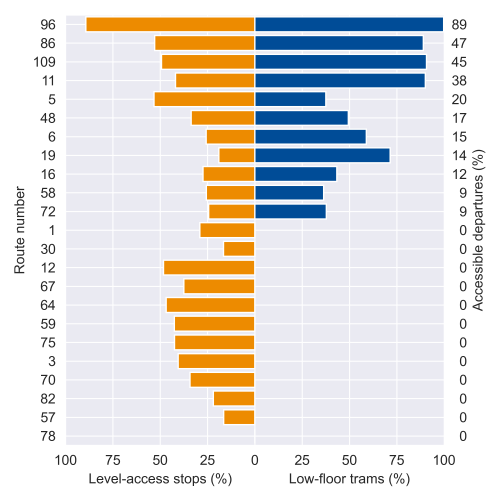
Source: VAGO, using DoT and YT data.
DoT and YT’s public information and applications (Public Transport Victoria Journey Planner and TramTRACKER) do not show accessible service patterns at chosen stops at a particular time or a specified day.
Providing this information would help passengers with mobility restrictions to better plan their required journeys.
Recommendation about public information on tram accessibility
| We recommend that: | Response | |
|---|---|---|
| Department of Transport | 5. within the limits of available operational data, publishes and maintains an interactive map of the network or a journey planner tool showing accessibility by stop, route and scheduled service (see Section 2.3). | Accepted |
Cost-benefit analysis of a complete level-access stop rollout
We overlaid the most recent Australian Bureau of Statistics (ABS) population data on all stops on the tram network to define geographic catchment zones of potential tram users within 500 metres of a tram stop.
Based on this analysis, we estimate that 7.5 per cent of Melbourne’s population (or 367 855 people) are within 500 metres of a non-level-access tram stop.
Using the ABS estimate that 17 per cent of the population is living with disability, we estimate there may be 62 535 people living with disability who are within 500 metres of a non level-access stop. The ABS data does not distinguish between people living with a disability that causes mobility restrictions and other types of disabilities. This approach is consistent with the way that DSAPT defines disability.
DoT has estimated that upgrading all non-level-access stops on the network to level access would cost at least $2 billion, with that estimate not including all accessibility requirements required by DSAPT.
Based on this cost, and an assumed useful life of a level-access stop of 30 years, we estimate that the cost of delivering accessibility via a level-access stop, for a person living with disability within 500 metres of a tram stop, would be $1 066 a head, per year, for 30 years.
This cost estimate drops to $181 per person, per year, if every potential tram user within the 500-metre catchment is considered a beneficiary of an upgraded stop. Practical features that enable accessibility, like level-access stops and low-floor trams, also benefit elderly passengers and people travelling with young children or using temporary mobility aids like crutches.
There is no evidence that DoT has formally considered any potential societal benefits that might accrue from a DSAPT-compliant tram infrastructure investment program. DoT could calculate this by commissioning a comprehensive cost-benefit analysis.
Recommendation about understanding costs and benefits
| We recommend that: | Response | |
|---|---|---|
|
Department of Transport |
6. commissions a comprehensive cost-benefit analysis into the full rectification or rationalisation of all tram stops that need to be upgraded to Disability Standards for Accessible Public Transport 2002 accessibility standards. In addition to identifying construction costs, the analysis should consider other potential societal benefits from the investment, such as:
|
Partially accepted |
Strategy for tram accessibility
DoT has no clear and consistent strategy or plan for trams that:
- aligns with DSAPT milestones and targets
- identifies the compliance gap between the ‛current’ and ‛desired’ network state
- identifies required costs and phasing of funding
- lists responsible parties for specific actions
- identifies dependencies and linkages to other plans or projects.
Without a unified accessibility strategy for tram infrastructure and rolling stock, DoT cannot know how or when it will be able to achieve DDA and DSAPT requirements.
DoT has developed, and the government has noted, comprehensive long-term plans for the tram network. However, these do not include specific actions to achieve the required accessibility and DSAPT compliance outcomes. DoT’s overarching plan for the tram network mentions DSAPT compliance. However, it does not explicitly focus on improving accessibility or identifying specific actions to meet legislated targets.
DoT has a public transport accessibility strategy called the Accessible Public Transport in Victoria Action Plan 2013–17. Its goal was to make public transport accessible, taking a whole of-journey perspective. This is in line with the Australian Government’s policy on public transport accessibility.
DoT developed an update to this strategy, which was approved by the previous Minister for Public Transport in February 2020. It has not been published yet, as it is under review by the new minister.
DoT’s updated strategy focuses on the overall experience of a traveller with disability or mobility restrictions, rather than on any specific actions that are required to achieve a transport network that complies with accessibility standards and anti-discrimination legislation.
A draft framework exists for tram stop prioritisation, using data from August 2018. DoT uses the framework on an ad hoc basis to help develop business cases, rather than to explicitly advise the government with a priority list for level access tram stop upgrades. DoT has no guidelines on how the framework should be used in planning and investment decisions.
DoT is updating this framework as a part of the Stop Rollout Strategy (SRS) project, which was funded in the 2019–20 Budget. The SRS is expected to develop an action plan to upgrade any remaining non-level-access stops to level access, including the preferred design and accessibility requirements for those stops. The SRS work will not be finished until June 2021 and is expected to support DoT’s future Budget bids. However, there is no guarantee that the action plan will be implemented until it is funded by the government.
Modular or offsite fabrication refers to the process of pre building a stop at a factory before installing it at a final location.
DoT does not have a standardised design approach for accessible tram stops and has not yet explored construction innovations (such as modular or offsite fabrication) that could reduce costs and speed up installation.
The tram infrastructure area of DoT has not formally consulted other infrastructure delivery teams in the transport portfolio to share experiences. This consultation would be a good opportunity to share cost and delivery lessons from the recent rapid rollout of new railway stations, level crossing removals and major road projects.
Recommendation about linking programs to accessibility outcomes
| We recommend that: | Response | |
|---|---|---|
| Department of Transport | 7. further develops the overarching plan for the tram network and future planning to more explicitly link to Disability Standards for Accessible Public Transport 2002 compliance dates and accessibility outcomes by:
|
Accepted |
8. enhances the existing tram Stop Prioritisation Framework by:
|
Accepted | |
9. further develops the tram-specific elements of the rolling stock plan and strategy so that it:
|
Accepted | |
10. researches and develops new approaches to the design and delivery of accessible tram stops by:
|
Accepted |
1. Audit context
Accessible public transport is important for people living with disability or temporary injury, the elderly, and people travelling with young children.
DSAPT sets targets for when public transport operators and providers must provide fully compliant transport services. The next milestone is 31 December 2022 for transport infrastructure. The final milestone for rolling stock is on 31 December 2032.
DoT and YT are responsible for ensuring the tram network is accessible for all and complies with relevant accessibility standards and anti-discrimination legislation.
Practically, the two key enabling elements that make the tram network the most accessible for people with mobility restrictions are the combination of low-floor trams and level-access stops.
This chapter provides essential background information about:
1.1 Melbourne’s tram network
Melbourne has the world’s largest tram network, which has been operating since it was first established in 1889. The current network consists of 24 tram routes that run on 250 kilometres of double track using 1 669 stops.
The tram network connects Melbourne’s suburbs to the city. It is especially important for areas that do not have nearby train or bus services.
In 2018–19, one in three metropolitan public transport passenger boardings in Victoria were on Melbourne’s tram services. Figure 1A shows the number of passenger boardings per year.
FIGURE 1A: Passenger trips on Melbourne metropolitan public transport services per year
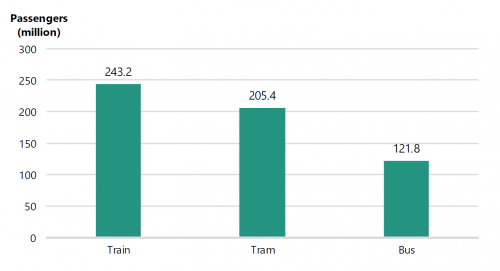
Source: Public Transport Victoria, Annual Report 2018–19.
The age, historical significance and physical constraints of Melbourne's tram network mean that modernising it is very difficult. A large proportion of trams on the network have been running since the 1970s and 1980s.
Melbourne’s tram system mainly runs in mixed traffic alongside trucks, cars, pedestrians and cyclists. Therefore, it cannot fully use the improved accessibility of modern low-floor trams without retrofitting level-access stops into the roadway.
The United Nations’ Convention on the Rights of Persons with Disabilities defines universal design as ‛the design of products … to be usable by all people to the greatest extent possible without the need for adaptation or specialised design.’
A universally designed tram network focuses on user experience and seeks to address the full range of human capabilities—from mobility restrictions to those encumbered with bikes or pram.
Upgrading tram stops can be a complex and lengthy process. It involves consultation with local councils, coordination with road traffic authorities, and potential construction constraints due to heritage rules or the unique geography of a site.
Improving accessibility on the network can also require a balancing of competing pressures from non-accessible heritage designs and aesthetics against modern universal design concepts.
Accessibility of the tram network
From a practical perspective, low-floor trams and level-access stops are the two key enabling elements needed to make the tram network more accessible.
Level-access stops are raised platforms that make a tram stop level with the doors of a low-floor tram. When paired with a low-floor tram, people with mobility restrictions can board and alight from trams with ease.
Level-access stops without low-floor trams (or vice versa) also provide some accessibility outcomes for some people with disability, such as improved environments for people with vision or hearing impairments.
However, having one element without the other results in a barrier to fully accessing public transport for people with mobility restrictions. This is contrary to the human rights concept of universal access, and thus could discriminate against people with more acute accessibility needs.
Figure 1B shows a level-access stop in Melbourne.
FIGURE 1B: Example of a level-access stop with a low-floor tram
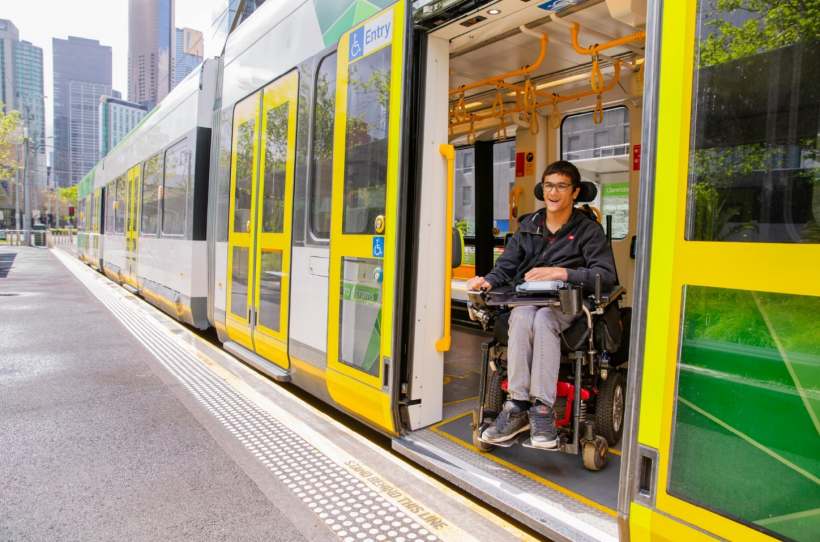
Source: YT.
Non-level-access stops require passengers to step up onto a tram, whether it is a low floor tram or not. Figure 1C shows a low-floor tram at a non-level-access stop.
Figure 1C also shows that passengers need to step down from the kerb, into the roadway and up onto the tram. Therefore, passengers using a wheelchair or mobility aid buggy cannot board low floor trams without a level-access stop.
FIGURE 1C: Example of a non-level-access stop and a low-floor tram
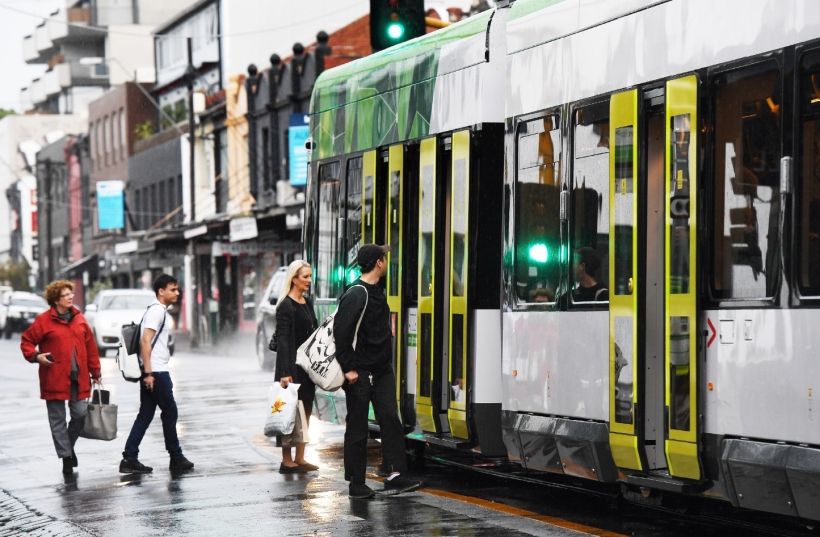
Source: YT.
Melbourne’s tram fleet has nine classes of vehicles, which vary in size, passenger capacity, and technical capability. There are approximately 500 trams on the network, with eight of those listed as heritage trams (W-Class) that are only used on the City Circle free tourist route. DoT considers the W-Class to be working heritage trams and the City Circle route as a tourist attraction, not a regular tram route.
Figure 1D shows the different vehicles running on Melbourne’s tram network. The first low-floor tram was introduced in 2001.
FIGURE 1D: Types of trams running on the tram network
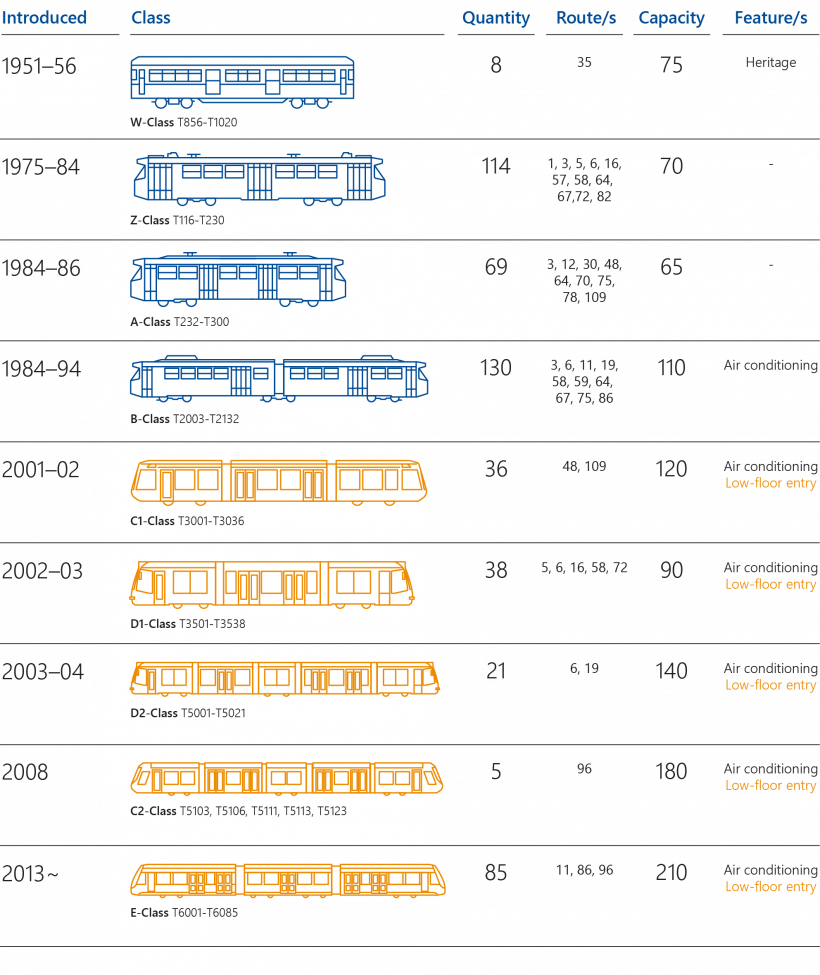
1.2 Legislative requirements for accessibility
The DDA defines discrimination as treating a person with disability less favourably than a person without disability.
DSAPT requires more than just level-access stops and low-floor trams. Relevant requirements include, but are not limited to, how wide an entry way needs to be, what signage and lighting is required, or what vertical or horizontal gap is permitted between a platform and a vehicle.
Federal and state legislation views accessibility from the perspective of avoiding discrimination. The federal DDA and the Victorian EOA both make it unlawful for an operator or provider of public transport to discriminate against a person with disability.
Figure 1E summarises the relevant legislation relating to public transport accessibility.
FIGURE 1E: Hierarchy of legislation relevant to public transport accessibility in Australia
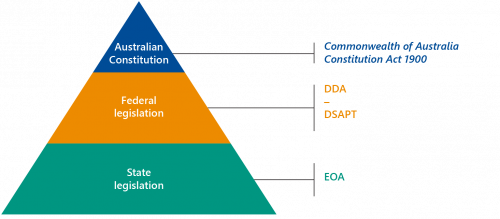
Source: VAGO.
Disability Discrimination Act 1992
The DDA makes it unlawful to discriminate against a person because of disability. This restriction extends to employment, education, the provision of services (such as public transport), and access to public spaces.
DDA defines disability as including temporary or permanent disabilities that are or have been experienced in the past, present or future.
Disability Standards for Accessible Public Transport 2002
DDA does not specify how a public transport operator or provider should ensure it is not discriminating against a person with disability. For this reason, the Australian Government enacted DSAPT. DDA states that it is unlawful to contravene DSAPT.
DSAPT sets minimum design requirements for:
- trams, trains, ferries, accessible taxis, light rail and buses
- tram and bus stops and train stations
- public transport information.
A part refers to an accessible feature required by DSAPT. For example, access paths, ramps, allocated spaces, or symbols are all considered individual parts. Within each part are specific requirements relating to the part. For example, within the access path part there are seven specific tram infrastructure and rolling stock requirements.
DSAPT outlines design requirements in 30 different DSAPT parts. Those parts include, but are not limited to:
- clear access paths
- resting points for paths that are longer than 60 metres
- grabrails or handrails on steps or access paths
- international symbols for accessibility and deafness to identify access paths, accessible facilities and boarding points
- priority seating.
All modes of public transport must be fully compliant with DSAPT by 31 December 2032. DSAPT has specified target dates allowing incremental compliance from December 2002 to December 2032.
Figure 1F shows each DSAPT milestone, the level of compliance for tram services and the relevant part.
FIGURE 1F: Agency responses to assurance review
| Milestone | Specific parts to be 100% compliant | Overall compliance target for all other parts |
|---|---|---|
| 2007 | Waiting areas, furniture and fittings, information, priority seating, symbols, signs, alarms, lighting and hearing augmentation | 25% |
| 2012 | Gateways, surfaces, and handrails and grabrails | 55% |
| 2017 | Resting points, boarding, allocated space and street furniture | 90% |
| 2022 | All infrastructure except for trams (vehicles) | 100% |
| 2032 | All infrastructure and trams | 100% |
Source: DSAPT.
DSAPT gives transport operators and providers certainty about their obligations under DDA to remove discrimination from public transport services. Implementing the standards reduces the potential for a complaint of unlawful discrimination under DDA.
Exemptions from DDA and DSAPT
Public transport operators and providers can apply to AHRC for an exemption from DDA and DSAPT requirements, which protects them from discrimination claims. AHRC may grant exemptions for up to five years.
Exemptions are not an excuse to take no action. If AHRC grants an exemption, the public transport operator or provider must still plan for how it will achieve DDA and DSAPT compliance when the exemption expires.
Figure 1G explains the role of AHRC in giving exemptions.
FIGURE 1G: DSAPT exemptions
AHRC publishes on its website the DSAPT exemptions it has granted, including the rationale for each exemption. An example is an exemption AHRC granted to the Australasian Rail Association (ARA) (which includes DoT and YT as members) for DSAPT Part 2.4, which relates to access paths.
This DSAPT part requires that an access path must be a minimum unobstructed width of 1 200 millimetres. However, the temporary exemption allows for an unobstructed width of 1 000 millimetres if DoT and YT cannot meet the 1 200 millimetre width due to structural and technical constraints. Likewise, two of the other exemptions (for Parts 2.4 and 4.2) include changes to dimensional requirements.
All of the eight tram exemptions were subject to conditions. These conditions included providing an annual written report to AHRC that addresses the availability of alternative systems, and that ARA publishes these reports.
Source: VEOHRC, DoT and YT information.
In determining if a public transport operator or provider experiences unjustifiable hardship, AHRC may consider the financial circumstances of a transport operator or provider, the heritage nature of infrastructure and rolling stock, or the detriment that noncompliance may cause to a person with disability.
Strict compliance with DSAPT is not always possible. DSAPT provides for a defence where compliance with prescriptive requirements in DSAPT would result in an unjustifiable hardship for the public transport operator or provider.
A public transport operator or provider who is unable to comply with DSAPT may also take alternative action by providing equivalent access for transport users.
Reviews of DSAPT
DSAPT provides for a review of the efficiency and effectiveness of the standards every five years. The most recent review in 2012 (the proposed 2017 review was delayed and is currently underway) found that DSAPT may not be meeting the current and future needs of people with disability, or providing sufficient flexibility or guidance to transport operators in their efforts to comply with DDA. In particular, private transport operators faced the challenges of finding necessary resources to update rolling stock and associated infrastructure out of their own funds.
The 2012 DSAPT review made recommendations to the Australian Government. The most significant was to modernise DSAPT jointly with state and territory governments. The review initially intended for the modernisation process to conclude in 2017, however, the process was stalled until 2019.
The Australian Government is now working with state and territory governments to modernise DSAPT to address the issues identified in the 2012 DSAPT review. Any legislative amendments to DSAPT from this process are not expected to be ready until late 2021.
Equal Opportunity Act 2010
Unlike DDA, the Victorian EOA does not require a legal instrument to explain how a public transport operator or provider might avoid discriminating against a person with disability. Instead, it imposes a ‛positive duty’ to eliminate discrimination by taking ‛reasonable or proportionate’ measures.
VEOHRC defines positive duty as ‛addressing the systemic causes of discrimination, sexual harassment and victimisation’. It requires organisations to be proactive rather than reactive in taking steps to prevent discrimination.
The EOA gives examples of what a reasonable and proportionate measure might be. This includes:
- ensuring all staff are aware of an organisation’s commitment to ensuring all staff are treated with fairness or respect
- undertaking an assessment of an organisation’s compliance with the EOA.
If there are any inconsistencies between the EOA and DDA, the Australian Constitution states that federal law, which in this case is DDA, prevails.
Consequences of noncompliance
Individuals who suffer unlawful discrimination need to make a complaint to AHRC about noncompliance with DDA and DSAPT to get a finding in their favour, which may be used to trigger other possible consequences for the party in breach.
Similarly, if a person is discriminated against in the provision of public transport in Victoria, they can make a complaint to VEOHRC for breaches of the EOA. Complaints are a primary method to make sure public transport operators and providers comply with DDA, DSAPT and EOA.
A secondary method uses VEOHRC’s powers to investigate disability discrimination matters. VEOHRC investigations can be published and tabled in Parliament or referred to the Victorian Civil and Administrative Tribunal.
The Victorian Civil and Administrative Tribunal may make orders that require public transport operators or providers to prevent further discrimination on the tram network and can also make site-specific legal orders to rectify particular items, such as rebuilding a nominated tram stop to meet DSAPT accessibility standards.
1.3 Transport disadvantage and mobility restriction
People living with disability or mobility restrictions often face difficulties when accessing transport. The Australian Institute of Family Studies defines this as ‛transport disadvantage‘.
Tram users may face transport disadvantage if there are:
- ineffective communication facilities, such as no audible announcements on the tram or no visual signage, meaning that not all passengers know which stop they are approaching
- inadequate handholds or waiting zones, meaning that some passengers cannot use the platform or board a tram without assistance
- high stairs or steps, meaning that boarding and disembarking is difficult or impossible for some passengers.
Figure 1H summarises key information from 2018 ABS data about people with disability.
FIGURE 1H: Statistics about people with disability (2018)
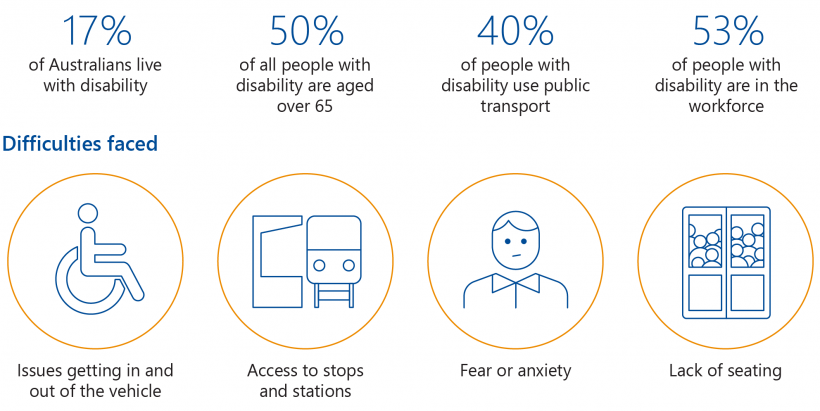
Source: ABS's 2018 Survey of Disability, Ageing and Carers, 2018.
1.4 Agency roles and responsibilities
DoT and YT are both responsible for implementing EOA, DDA and DSAPT requirements on the tram network.
Department of Transport
DoT is responsible for long-term planning and strategy for transport matters in Victoria. This includes contractual and operational oversight of the various public transport operators in the state, such as metropolitan and regional buses, Metro Trains Melbourne, YT, and V/Line Corporation.
DoT merged with Public Transport Victoria and VicRoads in July 2019. Public Transport Victoria was formerly responsible for planning and overseeing performance of the public transport network. As a result, DoT‘s role now includes the coordination and integration of Victoria‘s transport system.
Yarra Trams
KDR Victoria Pty Ltd is a private entity engaged by the state to run Melbourne’s tram network using the YT brand name (owned by the state). YT has operated the tram network since November 2009 under two different contracts known as franchise agreements. The current franchise agreements are collectively known as Franchise Agreement - Tram. The process to develop the agreements was known as Metropolitan Rail Franchising No. 4 (MR4).
The tram-related contracts developed under MR4 make YT responsible for the day to-day operations, management, and maintenance of the network. YT works alongside DoT to help provide an integrated public transport service for Melbourne.
YT also provides formal advice to DoT on various safety, design and operational matters due to its role as the accredited rail operator for the tram system.
1.5 Government policy on accessible transport
The Australian Government's Whole Journey guide
In 2017, the Australian Government released The Whole Journey: A guide for thinking beyond compliance to create accessible public transport journeys (The Whole Journey). It created the guide in response to a 2012 review of DSAPT, which found that the standards were effective in removing discrimination but not optimal.
All state and territory transport ministers endorsed the guide in November 2017.
The purpose of The Whole Journey is to encourage policymakers, designers, builders, certifiers and operators to think beyond compliance and focus on peoples' accessibility needs across their whole journey on public transport.
Accessible Public Transport in Victoria Action Plan 2020–24
Victoria‘s approved but unpublished Accessible Public Transport in Victoria Action Plan 2020–24 takes a whole-of-journey approach to accessibility. It seeks to identify and change public transport practices that may result in discrimination against people with disability.
DoT‘s action plan focuses on giving people with disability the opportunity to plan their journey and access information when travelling, as well as providing better physical access to different modes of transport.
DoT‘s action plan is underpinned by five priorities, shown in Figure 1I.
FIGURE 1I: Priorities of DoT's action plan

Source: DoT's Accessible Public Transport in Victoria Action Plan 2020–24.
1.6 Related audits
Our 2009 audit Making Public Transport More Accessible for People Who Face Mobility Challenges found that compliance levels on tram services fell short of the targets required by DSAPT in 2002 and 2007.
The audit identified a ‛critical shortfall’ in the upgrading of trams and tram stops within DSAPT target dates. This shortfall was because:
- government policy was to replace older trams when they reached the end of their design lives, however, that was not quick enough to achieve the targets
- it was both difficult and expensive to upgrade the required number of tram stops, and this was conflicting with other road space uses.
As a result, we concluded in 2009 that DoT would not achieve the 2012 DSAPT targets.
The audit made seven recommendations to DoT, who accepted all of them. These included developing a plan to achieve system-wide compliance for trams and tram stops as a priority. This would inform the community about how and when DoT would meet DSAPT requirements.
The audit also recommended that DoT improve its understanding of how people with disability use and want to use public transport, as well as their satisfaction with the changes made so far and their priorities for future change.
2. Accessibility of the tram network
DoT has not met the targets set by DSAPT and there is no realistic prospect that DoT can meet the target of 100 per cent DSAPT compliant tram infrastructure by 31 December 2022. If DoT continues the current low-floor tram delivery rate, it will not meet the 31 December 2032 target of 100 per cent accessible trams.
DoT has focused on implementing level-access stops and low floor trams. Although these are key practical enablers of DSAPT compliance, they alone do not fully meet DSAPT. DoT does not know the true extent of its compliance with DSAPT because of gaps in the accuracy, completeness and reliability of its data.
As previous tram exemptions have expired, DoT and the State of Victoria are likely in breach of DSAPT. This exposes the state to the risk of discrimination complaints and other legal actions. Most importantly, it means the tram network is not accessible to all members of the community.
This chapter discusses:
2.1 Defining accessibility
To improve network accessibility, DoT has primarily focused on delivering level-access tram stops and low-floor trams.
From a practical perspective, these two features are necessary to make the tram network more accessible. For example, a level-access stop could be a means towards achieving an unhindered access path (Part 2.6, DSAPT). However, a level-access tram stop and a low-floor tram alone will not satisfy DSAPT, which requires that both the infrastructure (tram stop) and conveyance (tram) meet all relevant parts identified in the standards.
Figure 2A shows the 26 DSAPT parts for tram infrastructure and rolling stock that are required for a tram service to be considered fully accessible.
FIGURE 2A: DSAPT tram infrastructure and rolling stock parts
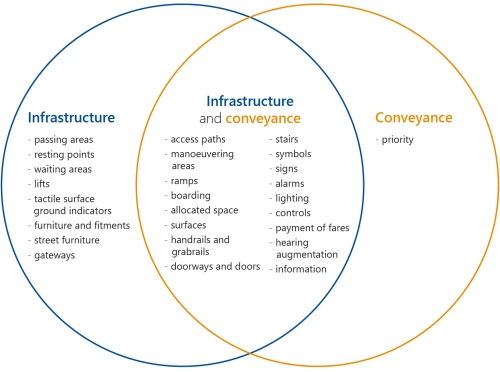
Note: There are four DSAPT parts that are not tram-related and are not included in this figure. These are toilets, booked services, food and drink services, and belongings.
Source: DSAPT.
Fewer than half (11) of Melbourne’s 24 tram routes are serviced by low-floor trams, and only four are solely serviced by low-floor trams. Of the 1 669 tram stops on the network, 454 are level access (or 27 per cent). There are 185 low-floor trams (or 38 per cent of all trams) and 307 high-floor trams servicing the network, not including the W-Class working heritage tourist trams.
Of all tram services that ran in 2018–19, only 15 per cent had a low-floor tram depart from a level-access stop. Figure 2B shows the proportion of level-access tram stops, low-floor trams, and services that had both of these key practical enablers of accessibility.
FIGURE 2B: Proportion of level-access tram stops, low-floor trams and services that had both
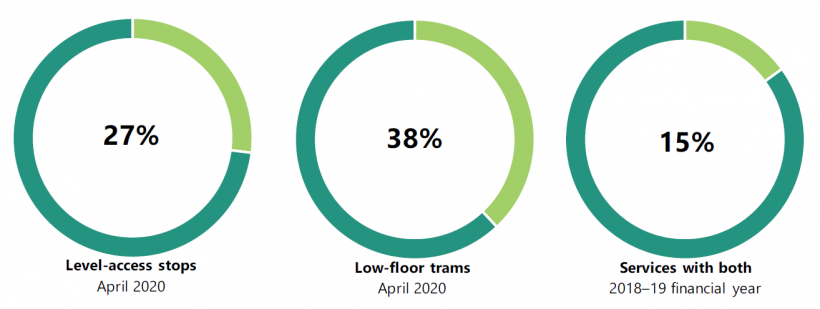
Note: Tram services with level-access stops and low-floor trams are a practical enabler of accessibility for passengers with mobility restrictions.
Source: VAGO, using data from DoT and YT.
Appendix D of this report shows the detail related to compliance requirements and targets for DSAPT-compliant tram transport as well as our assessment of achievement.
2.2 Meeting the legislated DSAPT targets
Legislation requires that 100 per cent of tram infrastructure on the network, which includes tram stops, must be compliant with DSAPT by 31 December 2022.
For trams, the deadline is 31 December 2032.
At DoT’s current rate of delivery, it is extremely unlikely that it will meet the 31 December 2022 target for tram stops.
DoT is also at risk of not meeting the 31 December 2032 target for trams.
Due to limitations in available data, we were not able to accurately forecast when DoT might meet these targets.
Figure 2C shows our estimate of when DoT will have upgraded all stops on the network to level access and all trams to low floor based on DoT’s historical rates of progress in doing these things.
FIGURE 2C: Projected achievement of full level-access stops and low-floor trams across the tram network
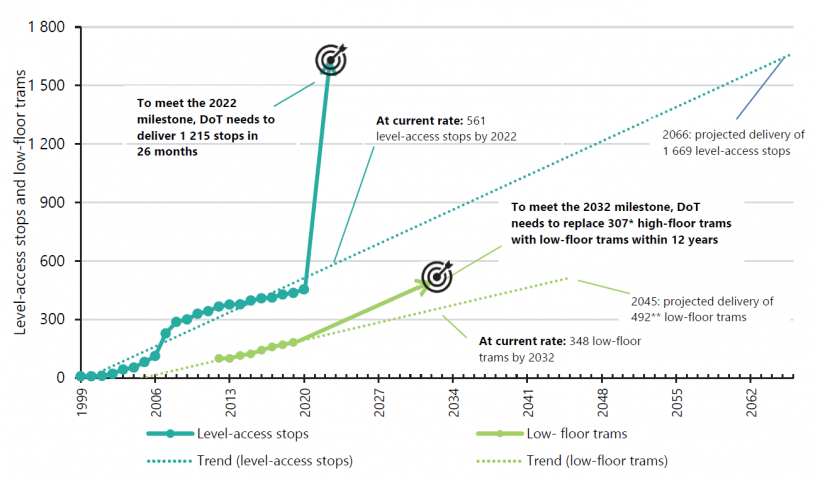
*This number assumes that the current tram fleet will remain the same size, however, DoT may decide to reduce or increase the fleet based on operational requirements and government funding decisions.
**This fleet number does not include the W-Class trams, which run on Route 35 (City Circle). These trams are all high-floor heritage trams and, according to DoT, are mainly tourist-focused.
Note: This projection is based on the current delivery rate of level-access stops and low-floor trams. It does not include the Next Generation Tram, which will not be delivered until 2024. These trams will replace the A, Z, and B class trams and are higher performing and more efficient. This replacement is further covered in Chapter 3.
Source: VAGO, based on information from DoT and YT.
Figure 2C shows that:
- by the 31 December 2022 infrastructure deadline, and based on the trend to date, DoT could deliver 561 level-access tram stops (leaving 1 108 stops to be rectified). However, DoT does not have approved funding for a rectification program to deliver level-access tram stops that comply with DSAPT, so the number of upgraded stops is likely to be much lower than the trend line shows
- by the 31 December 2032 vehicles deadline, based on the trend to date, DoT could deliver 348 low-floor and DSAPT-compliant trams (leaving 144 high-floor trams in the fleet), assuming the total fleet size does not change.
DoT advised us that it assumes it can meet the DSAPT-compliant low-floor tram target if:
- it decides by the end of 2020 on the design of the Next Generation Tram and the government approves and funds the build program
- it then commences and finalises the Next Generation Tram procurement process, which it estimates could occur in the 2021 calendar year
- the chosen manufacturer constructs and delivers the required trams from 2024 onwards, which is the earliest date of Next Generation Tram delivery, at a rate of at least 30 trams per year from year three of delivery
- the introduction of the Next Generation Tram allows service levels to be maintained while also reducing the overall fleet size.
To make sure that it meets the legislated compliance date, DoT will need to carefully assess its achievement against these assumptions, actively manage any preceding activities, and keep the government updated on progress.
We discuss the Next Generation Tram in more detail in Chapter 3.
Exemptions from DSAPT
As DoT’s franchisee, YT held eight tram-related exemptions that AHRC granted in 2015, which expired on 30 September 2020.
When it granted the previous exemptions, AHRC recognised in its published reasons that granting further exemptions would potentially have a greater impact on people with disability.
It noted that there could be no assumption that it would grant further exemptions to members of ARA. Rather, it would require ‛persuasive reasons’ to justify the impact an exemption would likely have on people with disability.
Figure 2D shows the exempted parts relevant to trams.
FIGURE 2D: DSAPT parts that YT had exemptions for up to 30 September 2020
| DSAPT Part | What it relates to |
|---|---|
| 2.1 (ii) | Unhindered access to access paths |
| 2.4 | Unobstructed widths of access paths |
| 2.6 | Entry ways to rolling stock |
| 4.2 | Unobstructed widths of two-way access paths |
| 11.2 | Provision of handrails on access paths |
| 14.3 | Design of stairs on rolling stock |
| 17.5 | Display of electronic notices |
| 20.1 | Lighting at stops |
Source: YT.
DoT and YT are both members of ARA, which is developing an application for a further series of DSAPT exemptions for rail transport modes. However, DoT and YT advised us that this application will not include exemptions that apply to the tram network.
YT also advised us that it did not intend to join a further exemption application. Instead, YT will focus on supporting the government to upgrade the tram network with level-access stops and accessible low-floor trams.
|
If an agency has an exemption ... |
Because ... |
|
The agency is protected from a discrimination claim during the time which the exemption applies |
The effect of an exemption is that a recipient is not contravening DSAPT if they fail to comply with DSAPT, but only for the specific terms of the exemption. |
|
The agency must still show that it is taking expected actions to meet DSAPT requirements |
An exemption is not an excuse for an agency to do nothing |
Figure 2E shows DoT and YT’s 2017, 2012 and 2007 DSAPT compliance target requirements provided as part of the exemptions and the current level of compliance according to the data recorded in DoT’s database.
FIGURE 2E: DoT and YT's current tram-related exemption targets and performance
| DSAPT reference number | Part | % compliance required | Actual % compliance | ||
| 2007 | 2012 | 2017 | as of April 2020* | ||
| 2.1, 2.4, 26 | Access paths | 25 | 55 | 90 | 63 |
| 4.2 | Passing areas | 25 | 55 | 90 | 74 |
| 11.2 | Handrails and grabrails | - | 100 | - | 22 |
| 14.3 | Stairs | 25 | 55 | 90 | 1 |
| 17.5 | Signs | 100 | - | - | 16 |
| 20.1 | Lighting | 100 | - | - | No data |
*These figures are subject to the database limitations discussed in this report.
Source: VEOHRC, DoT, and YT.
DoT has focused on level-access stops and low-floor trams as the main practical way to achieve DSAPT compliance. However, it has not fully addressed other accessibility features required by DSAPT. For example, as shown in Figure 2E, DoT has only upgraded 16 per cent of the tram network‘s signage, despite DSAPT requiring compliance across 100 per cent of the tram network by 2007.
The recent expiry of tram-related DSAPT exemptions on 30 September 2020 means that DoT and YT have no legislative relief in place, which may expose the government to discrimination complaints alleging breaches under DDA and DSAPT. DoT's track record of not meeting DSAPT targets means that it is likely to be in breach of DDA and DSAPT requirements. However, a formal breach finding can only be made once a complaint is lodged, tested and upheld.
2.3 Compliance achieved to date
DoT and YT do not have complete and accurate data to reliably quantify tram stop and tram compliance rates, so they cannot accurately report this. Notwithstanding this limitation, the data that DoT and YT holds shows, as at April 2020, that:
- DoT is compliant with only one tram infrastructure target (manoeuvring areas)
- DoT does not know how DSAPT-compliant the tram fleet is because it has not commissioned any independent tram compliance reviews.
Infrastructure (tram stops)
DSAPT specifies 25 different parts that a tram stop must satisfy to be accessible.
Each part has sub-parts, and to achieve compliance for the whole part, each sub-part must also be met. Figure 2F gives an example of a DSAPT part and the sub parts contained within it. Part 6 has both infrastructure and conveyance sub-parts, so it has two target dates. In these cases, the infrastructure and conveyance target dates apply to each sub-part.
FIGURE 2F: Example of a DSAPT part and its sub-parts
| DSAPT part | DSAPT sub-part | This applies to: |
|---|---|---|
| Part 6 Ramps | Part 6.1 Ramps on access paths A ramp on an access path must comply with Australian Standard 1428.2 (1992) Clause 8 |
Infrastructure only |
| Part 6.2 Boarding ramps A boarding ramp must comply with Australian New Zealand Standard 3856.1 (1998) Clause 2.1.8 (b), (c), (f), and (g) | Conveyances only | |
| Part 6.3 Minimum allowable width The minimum allowable width of a ramp is 800 millimetres |
Conveyances only | |
| Part 6.4 Slope of external boarding ramps The slope of an external boarding ramp must not exceed: (a) 1 in 14 for unassisted access (b) 1 in 8 for unassisted access where the ramp length is less than 1 520 millimetres (c) 1 in 4 for assisted access |
Conveyances only |
Source: DSAPT.
The majority of DSAPT infrastructure parts have a 100 per cent compliance requirement by 31 December 2022. DSAPT sets targets at five-year increments to allow for staggered accessibility upgrades on tram stops and trams.
We reviewed DoT’s data in April 2020 and found that it is incomplete and has some inaccuracies, and is therefore not fully reliable. DoT acknowledges that it cannot accurately report on its DSAPT compliance because of this.
According to DoT’s data, it had only achieved one target across the 26 tram related parts (manoeuvring areas, which were to be 90 per cent compliant by 2017 and recorded as 93 per cent compliant).
DoT has not achieved any of the 2007 or 2012 DSAPT targets. It is only complying with one of the 25 tram infrastructure parts and does not record any compliance data for nine of the required parts. Overall, DoT's data shows it is not complying with most of the other parts for which it has data.
Appendix D shows more detail for each of the required parts, the previous DSAPT targets, and our assessment of the current level of compliance that DoT’s data shows.
Level-access tram stops
A level-access tram stop is not a specific DSAPT requirement. However, DoT considers that they are a key practical enabling component to comply with DSAPT. This is because they are the most practical way to help passengers with a mobility restriction board and alight a tram without assistance in Melbourne’s mixed traffic environment.
DoT also considers that level-access stops can only be fully effective if they are combined with low-floor trams, or a tram fitted with lifts or ramps.
We interviewed tram users living with a variety of disabilities and mobility restrictions about their experiences on the tram network. Figure 2G shows the importance of a level-access stop for passengers with restricted mobility.
FIGURE 2G: Case study—Alex’s story
Alex* has cerebral palsy. This impacts Alex’s lower limbs and limits the range of motion in Alex’s legs. Alex uses two single-point sticks to move, and regularly catches the tram.
Living close to a tram stop with frequent trams means that Alex can freely and independently travel around Melbourne.
Alex believes that public transport is a cost-effective means for people living with disability to travel around and is generally satisfied that the existing tram network meets Alex’s own needs. However, Alex feels that the system is not as accessible for people with more acute accessibility needs.
Alex describes being reasonably mobile and that boarding a tram is not usually difficult. However, Alex ‛loathes’ the older class trams with a three step stair (A, B and Z-class). The steps on these trams are particularly high and due to Alex's lower limb limitations, climbing them promptly before the tram continues its journey is stressful. Getting off such a tram can also be difficult, as the final step to a level-access tram stop or road surface can destabilise Alex.
Tram stops that require Alex to walk on the road to get on or off the tram were initially stressful because of the exposure to the road and Alex’s limited walking pace. Alex acknowledges being much more adept at boarding and alighting at such stops over time, although stepping up and down between the road and the tram is still ‛a pain’.
On the tram itself, the standing bench cushions on B-Class trams allow Alex some comfort, since sitting can be painful for Alex’s spine. Handrails and poles inside the tram also allow Alex to maintain balance.
Alex prefers these over the plastic seats on newer D-Class trams, which require a passenger to step up into the seating bay. These can be slippery, and the extra step is an additional obstacle.
*For privacy purposes, we have not used the real names of case study subjects.
Source: Case study interview conducted by VAGO.
Analysis of tram routes and the accessibility of their services
Our analysis of tram stop data, scheduled trip data, and actual trip data from 2018–19, which was the most recent data available at the time of this audit, shows a significant gap in implementing services that combine level-access stops with low floor trams.
We joined different datasets held by DoT and YT, which had not been done before by either entity. Appendix E shows further technical information on the datasets and methods we used.
Our analysis shows that in 2018–19, 41.8 per cent of departures at level-access stops were low-floor, while 43.3 per cent of the available low-floor trams in the fleet serviced level-access stops. This highlights the mismatch between level-access stops and low-floor trams and is a missed opportunity to maximise improved accessibility on a route-by-route basis.
Less than a third of the stops on the tram network are level access. For tram users living with disability, particularly those who require a wheelchair or mobility-aid buggy, this means that much of the tram network is still not accessible for them.
Our analysis shows that only 11 of 23 tram routes (excluding the City Circle route) across Melbourne had some low-floor services in the 2018–19 financial year.
The 12 tram routes (excluding the City Circle route) without a low-floor tram at a level access stop are:
- Route 1—East Coburg to South Melbourne Beach
- Route 3/3A—Melbourne University to East Malvern
- Route 12—Victoria Gardens to St Kilda
- Route 30—St Vincent’s Plaza to Etihad Stadium Docklands
- Route 57—West Maribyrnong to Flinders Street Station
- Route 59—Airport West to Flinders Street Station
- Route 64—Melbourne University to East Brighton
- Route 67—Melbourne University to Carnegie
- Route 70—Wattle Park to Waterfront City Docklands
- Route 75—Vermont South to Central Pier Docklands
- Route 78—North Richmond to Balaclava
- Route 82—Footscray to Moonee Ponds.
The 11 routes with low-floor trams servicing level-access stops varied widely in the likelihood that a low floor tram would arrive at a level-access stop, ranging from 36.4 per cent of services on Route 5 to 99.8 per cent of services on Route 96.
This disparity between routes was caused by the type of tram that is run, with most routes running a mix of high and low-floor trams. The use of a mixed tram fleet also leads to a further variety of customer experiences when waiting for a low-floor service.
How long do passengers with a mobility restriction need to wait for a service that combines a low-floor tram and level-access stop?
Using the same data, we sought to understand the extra time a passenger with a mobility restriction may have to wait for a low-floor tram.
We identified the actual trams used for a particular trip on a specific route in 2018–19. The frequency of the arrival of tram services and a passenger’s wait time is defined by the route timetable, which varies.
For passengers who are able to board a high-floor tram, any tram that arrives at the stop is available for them. However, some passengers can only proceed with their journey when a low-floor tram arrives at a level-access stop.
The longest wait times for a low-floor service were experienced on routes 5, 16, 58 and 72. This largely reflects the low proportion of low-floor trams run on those routes.
Figure 2H shows the results from our data analysis.
FIGURE 2H: Additional wait times (minutes) for a low-floor tram service at a level access stop (on routes using low-floor trams)
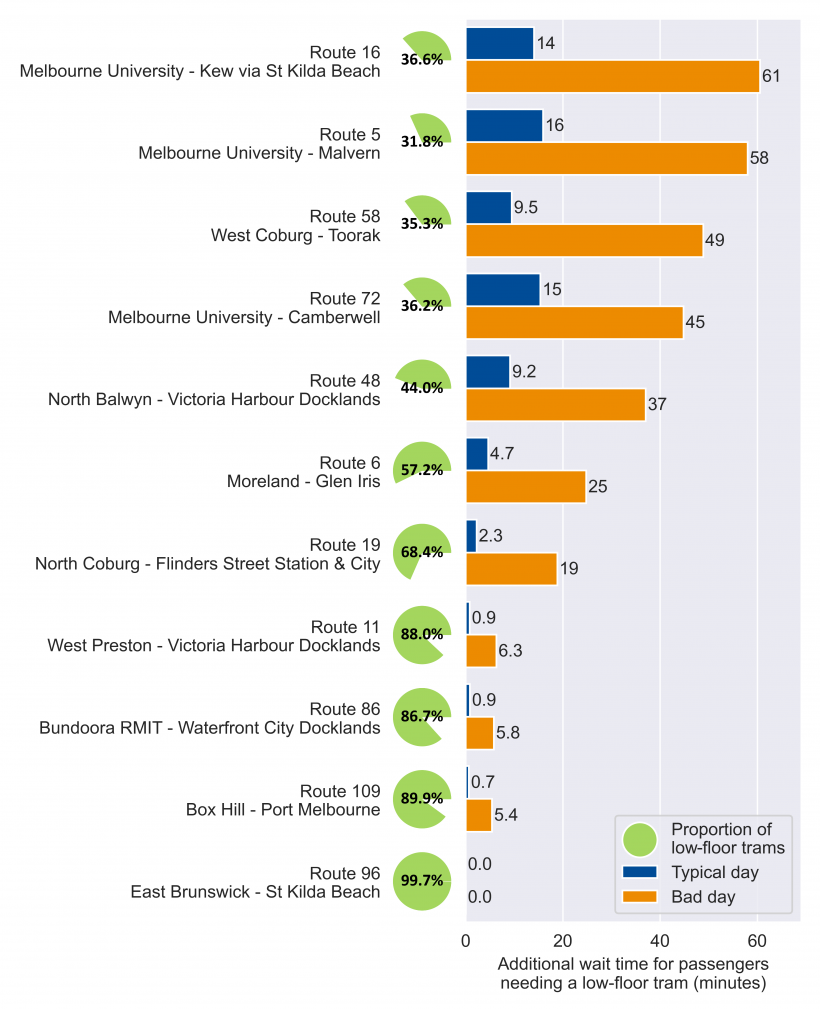
Note: Additional wait time refers to the extra time a passenger with a mobility restriction needing a low-floor tram has to wait over and above the next scheduled tram service if it is not low floor.
Note: A typical day denotes the median passenger wait time for a low-floor tram—50 per cent of the time wait times are better and 50 per cent of the wait times are worse than what is shown in blue.
Note: A bad day denotes that 95 per cent of the time a passenger’s wait time for a low-floor tram is better than what is shown in orange and 5 per cent of the time a passenger’s wait time is worse.
Note: A low-floor tram service must be boarded from a level-access stop.
Source: VAGO, using DoT and YT data.
Through this analysis, we also found that DoT and YT’s public information and mobile phone or computer applications (Public Transport Victoria Journey Planner and TramTRACKER) do not show low-floor service patterns at specified stops at a particular time on a specific day.
By joining relevant datasets, DoT and YT could publish an interactive map of the tram network to show the availability of a low-floor tram by stop, route and scheduled service. This would assist passengers with mobility restrictions to better plan their journeys.
Cost to upgrade noncompliant tram stops to level access
DoT estimated in 2019 that the average cost to upgrade a stop to level-access is $2–4 million, depending on location.
The cost of stop upgrades can differ due to the surrounding environment and location, with issues arising from heritage considerations, road width, traffic impacts, safety, and loss of existing on-street car parks. These complicating factors often delay or increase the cost of planned stop rollouts.
Tactile ground surface indicators (Part 18 of DSAPT) are raised ground textures installed at tram stops. These indicators assist in informing vision-impaired people of stairways, ramps, changes of direction, or any obstructions at the stop.
DoT’s estimated cost to upgrade the network’s infrastructure for DDA and DSAPT compliance was $612 million in 2009 (or $754 million adjusted to 2019 value). In 2020, DoT’s estimated cost to upgrade non-level-access stops to level-access stops (not including any cost for other DSAPT requirements like tactile ground surface indicators) is at least $2 billion
DoT asserts that these higher costs reflect the increasing complexity of upgrading a stop. However, DoT’s 2020 estimate does not include any analysis identifying why there has been a significant difference in cost since 2009.
While many previous upgrades had local stakeholder support or were delivered at stops with minimal impact to the surrounding environment, many of the remaining stops are in more complex environments requiring more stakeholder and local government consultation.
Notwithstanding these challenges, DoT advised us that a lack of funding has been the biggest obstacle to delivering more stop upgrades. For example, the 2017–18 and 2018–19 Budget cycles only funded one stop upgrade each.
Although DoT has put forward bids for additional funding, we have not seen evidence that it has asked for full funding to upgrade the entire network to meet the legislative requirements set by DDA and DSAPT.
Stop rationalisation for cost savings
DoT could reduce the overall estimated cost through rationalising stops (achieving more uniform spacing over a specific distance), as well as by removing or relocating some under-utilised stops.
DoT and YT have estimated that stop rationalisation could reduce the total number of stops on the network by 20 to 30 per cent. DoT wants to incorporate this option in its SRS, which is discussed further in Chapter 3. The work on the strategy is not yet complete and DoT has not yet identified any stops for rationalisation or removal.
Time needed to upgrade noncompliant tram stops
In its own documents, DoT has acknowledged that its approach to upgrading tram stops had been largely ‘reactive’ and ‘opportunistic’. Based on our analysis, we consider the approach has also been ineffective in meeting the required legislated targets.
Figure 2I shows DoT's rate of level-access stop delivery since 1999.
FIGURE 2I: DoT's delivery of level-access tram stops
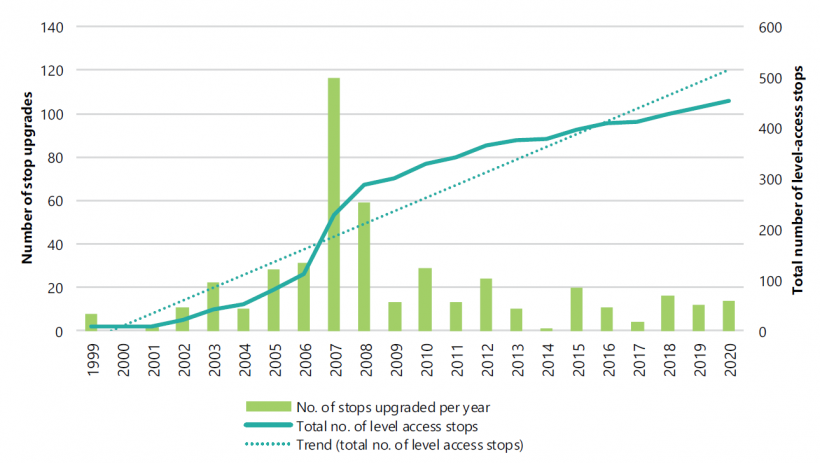
Source: VAGO, based on DoT and YT information.
It is highly unlikely that DoT can deliver the large construction program required to meet the DSAPT compliance deadline for tram infrastructure. We are also not aware of any funding allocated by the government to achieve the legislated requirement.
To achieve compliance before the 31 December 2022 infrastructure deadline, DoT would need to commence and deliver 46.7 level-access stops (that are also DSAPT compliant) per month over 26 months. This projection does not include any work that DoT may need to carry out on existing level-access stops to achieve full DSAPT compliance.
Part 8 of DSAPT requires a manual or power-assisted boarding device to be available at any accessible entrance to a tram. This device must be available for use at all designed stops and must be deployed if a passenger requests its use.
In 2007—DoT’s most productive year—it delivered 116 level-access stops, or 9.7 stops per month. For this, DoT used specific funding allocated to VicRoads as part of the Think Tram Initiative. Since then, DoT’s delivery rate has dropped significantly, mainly due to available funding.
Based on DoT’s experience, a level-access stop usually takes about three weeks to build. However, many months and sometimes years of design, planning approvals, stakeholder discussions and procurement processes need to occur before construction begins.
Figure 2J highlights the impact of the rollout delay on users who require both a level access tram stop and a low-floor tram to access the tram network.
FIGURE 2J: Case study—Chris’s story
Chris* has a lifelong muscular wastage condition, relies on an electric wheelchair to get around and is a regular tram user.
For Chris, most of the tram network is inaccessible. Many stops in the inner city are level access, but there are still significant portions of Melbourne where Chris cannot go by tram because of the lack of level access stops coupled with low floor trams. Chris believes that the gaps between accessible tram stops are too large.
At times, Chris’s wheelchair has been caught in the gap between the tram floor and the level-access stop. Only the C1-Class trams are fitted with a boarding assistance device, which narrows the gap and helps Chris board the tram. These trams run on Chris’s preferred route. However, when a tram with no boarding assistance device arrives, members of the public have helped Chris board the tram.
When on the tram, Chris can usually find a spot to park the wheelchair. However, Chris has found that tram models have inconsistent dimensions, which at times makes parking it difficult.
Chris has found the ‛super stop’ (level-access) upgrades to be the most significant improvement in Chris’s ability to travel through Melbourne. Chris believes that implementing more of these and raised road stops would greatly improve the overall accessibility of the tram network.
While Chris believes that DSAPT compliance would meet their needs as a wheelchair user, Chris says that upgrading the network would also benefit those without disability, such as the elderly and people on low incomes who cannot afford rideshare travel.
A super stop was a term previously used for a stop that has a raised platform to allow easy access to low-floor trams. It can include additional features, such as touch screen information, ticketing machines, passenger information displays and next tram announcements. Collins Street, Town Hall (at the corner of Collins Street and Swanston Street) is an example of a super stop. YT now refers to these types of stops as level-access stops.
*For privacy purposes, we have not used the real names of case study subjects.
Source: Case study interview conducted by VAGO.
Trams
DoT and YT do not have fully reliable data about the number of DSAPT-compliant trams operating on the network. This is because DoT and YT have not yet reviewed tram compliance against DSAPT requirements.
DoT primarily focuses on whether trams have a low floor and asserts that this feature is the key means to achieving DSAPT compliance. Even though it is the most practical way to enable accessibility, a 'low-floor' is not one of the 18 DSAPT parts that are relevant to trams.
Low-floor trams
Melbourne has five different classes of low-floor trams—the C1, C2, D1, D2, and E classes. Although these service 11 of Melbourne's 24 tram routes, only 15 per cent of departures on Melbourne’s network offered a low-floor tram at a level-access stop in 2018–19. The combination of these two practical elements of accessibility is required by a passenger with a mobility restriction to use a tram service.
Each class of tram has a different passenger capacity. The E-Class trams, which are low floor and can hold 210 passengers each, run regularly on three of Melbourne's 24 tram routes.
YT records the total number of trams (including high-floor trams) and class of trams which operate from the eight tram depots across Melbourne. Figure 2K shows the number of low-floor and high-floor trams currently on the tram network. As of 2020, 62 per cent of the network are high floor and 38 per cent of trams are low floor.
FIGURE 2K: Comparison of low-floor and high-floor trams in the fleet
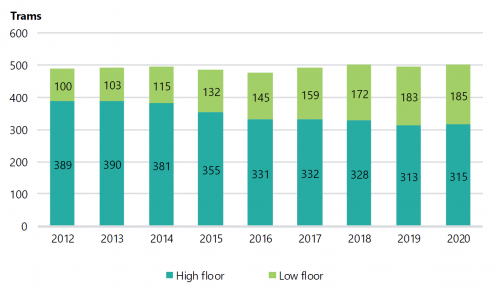
Note: *This number does not include the W-Class trams that run on Route 35. These trams are all high floor and according to DoT, are limited as tourist-focused trams.
Source: VAGO, based on information from YT.
Part 8.2 of DSAPT requires that a manual or power-assisted boarding device must be available at any accessible entrance to a tram that has:
a) a vertical rise or gap exceeding 12 millimetres or
b) a horizontal gap exceeding 40 millimetres.
However, DSAPT is silent on the need to install a boarding device, lift, or ramp at every tram stop.
Most trams on the network still have a high floor. However, the gradual increase in low-floor trams in the fleet shows that DoT has taken some action to replace the legacy high floor trams.
In 2011, DoT investigated the feasibility of installing lifts or ramps on existing low floor trams as an interim measure to improve accessibility where stops were not upgraded to level access. DoT’s report determined that:
- ramps are too unsafe or unwieldy to be used, except in emergencies
- the technical, operational and cost factors associated with installing lifts at certain stop types (kerbside access and median access stops) makes them unviable
- installing lifts in low-floor trams would not make trams accessible for people reliant on mobility aids due to existing road kerbs, and issues around available space at tram stops or in the road may prevent the lift from deploying properly.
Instead, DoT has focused on developing level-access stops as the primary means of achieving accessibility for low-floor trams.
However, Figure 2L shows that that the combination of low-floor trams and level access stops alone does not meet the accessibility needs of all passengers who live with disability or a mobility restriction.
FIGURE 2L: Case study—Sam’s story
Sam* has no vision and uses a seeing-eye dog. Sam relies heavily on all modes of public transport and is a regular tram user.
DSAPT does not have a specific part relating to space for mobility assistance animals on trams.
Part 9 covers the minimum allocated size for a mobility aid (800 metres by 1300 millimetres). DSAPT defines an allocated space as one that can accommodate a wheelchair or similar mobility aid. It is unclear whether service animals are included within this definition.
Sam relies on a seeing-eye dog named Cooper* to get around, but also participates in outdoor activities, such as tandem bike riding and skiing. Sam regularly travels independently on public transport and categorises their mobility skills as being at the ‛high end’.
Nevertheless, Sam states that physically locating the tram stop is one of the most challenging features of tram travel.
Sam uses two phone apps to locate a tram stop. Although these enable Sam to find the nearest stop, the next challenge is determining whether the stop is kerbside or in the middle of the road. There is often insufficient information at the stop to help Sam determine this.
Sometimes Sam has opted to walk to a familiar location that is three or four stops further down the tram route where Sam knows the set-up of the stop. Sam would like to see an additional feature on the tramTRACKER app that identifies the type of stop.
Cooper always travels with Sam. However, there is often insufficient room for Cooper under the tram seat. This is particularly troublesome on a crowded tram where Cooper’s space is even more constrained. Sam will often be unaware if there is available space until Sam and Cooper have boarded the tram, at which point it is already too late to exit.
While on a tram, Sam relies on audio announcements. However, these announcements are sometimes too quiet, which adds stress to travel because Sam must always focus on listening. Some trams do not have audio announcements at all.
Sam says that compliance with DSAPT is a good start. While low-floor trams and level-access stops are not critical for people with vision impairments, Sam states that most people with low vision are elderly.
For them, stepping on and off a tram is an additional challenge, so a level-access stop would be helpful.
Part 27 of DSAPT requires that general information about transport services must be accessible to all passengers. This includes the size and format of printing.
There is no explicit requirement for trams to have a public address system. However, DSAPT does require that all passengers are given the same level of access to information on their whereabouts during their journey. The standards do not expand on what this would include.
*For privacy purposes, we have not used the real names of case study subjects.
Source: Case study interview conducted by VAGO.
Geographic and population analysis of level-access stops on the network
Our analysis of DoT and YT data shows that although some parts of the network have level-access stops and some routes are running low-floor trams, a passenger may not experience both at a particular location.
Figure 2M maps Melbourne’s tram network and shows whether each tram stop is level access or not. If it is level access, the figure also shows the percentage of low floor trams that service that stop.
FIGURE 2M: Melbourne’s tram network and accessible services from each stop
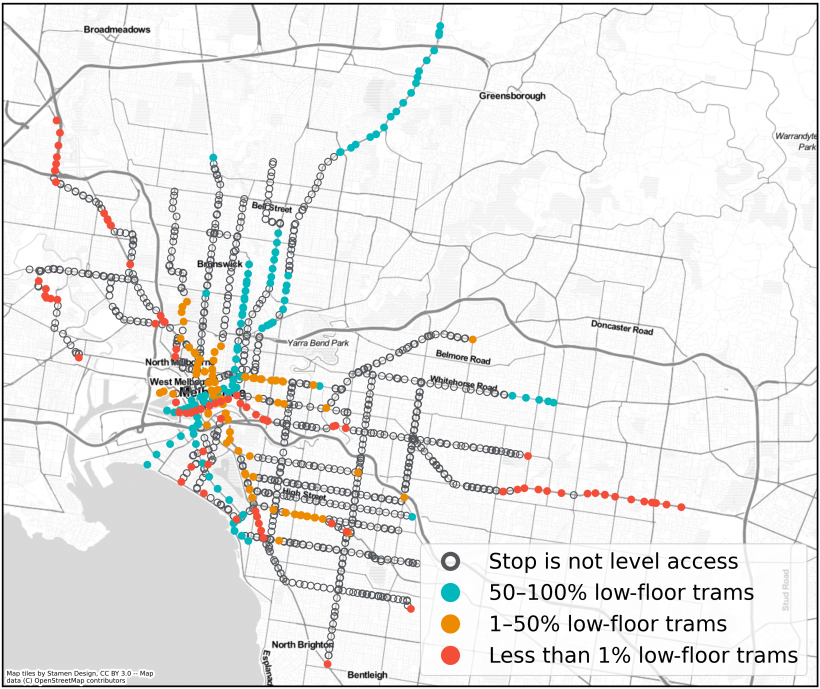
Source: VAGO, using data from DoT and YT.
Although 27 per cent of tram stops are level-access, they are not always serviced by a low-floor tram, which reduces accessibility for some passengers living with disability, especially wheelchair and mobility buggy users.
In particular, the red dots in Figure 2M and 2N show stops that are level access but have very limited low-floor tram services. In a practical sense, they are not accessible for passengers who require both a level-access stop and a low-floor tram to board and alight a service.
DoT has not identified how to better link the rollout of low-floor trams to level access stops. To do so would maximise practical outcomes for accessibility across the network. DoT has not specifically focused on upgrading stops to level-access in advance of low-floor trams being deployed onto new routes.
The DSAPT compliance target for tram stops is earlier than for trams, so some passengers with a less severe mobility restriction would also likely benefit from a level-access stop that is not serviced by a low-floor tram. This is because a level access stop reduces the step-up height for a high-floor tram and can provide more safety if segregated from road traffic, among other potential benefits.
We examined tram stops in the central area of Melbourne, where there is high tram patronage and many opportunities for interchange with other tram routes as well as buses and trains. We found that practical outcomes for accessibility at different tram stops is also varied, as Figure 2N shows.
FIGURE 2N: Melbourne central areas and tram stop accessibility
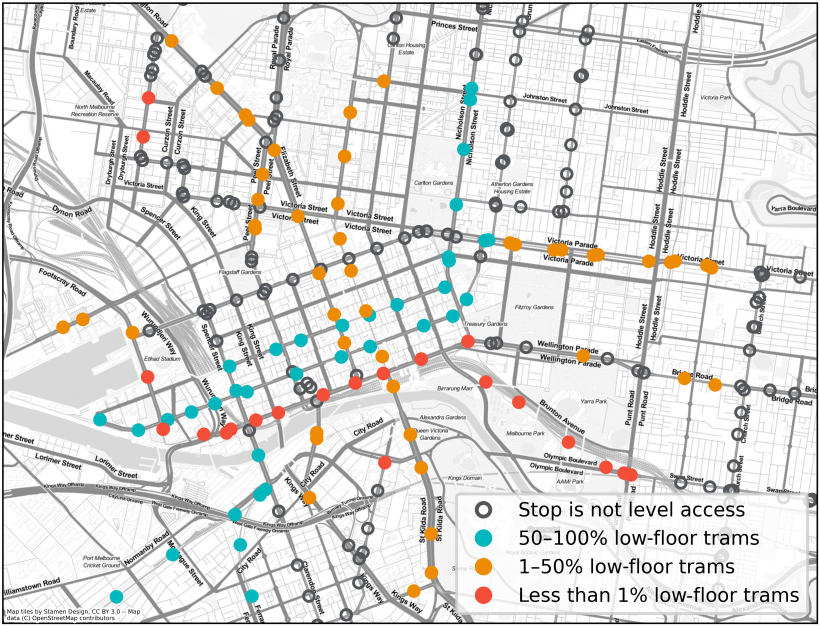
Source: VAGO, using data from DoT and YT.
Many of the tram stops in the central area of Melbourne are the busiest on the tram network, and if upgraded would therefore provide more accessibility to a high proportion of tram network passengers.
Impact of providing a more accessible tram network
We analysed recent population data to see what impact a full rollout of DSAPT compliant infrastructure would have on potential tram passengers within 500 metres of an upgraded level-access stop.
We overlaid the most recent ABS population data to define geographic catchments near tram stops. Figure 2O shows the results of this analysis and maps the population density of greater Melbourne to the tram network.
FIGURE 2O: Population density of greater Melbourne and the tram network
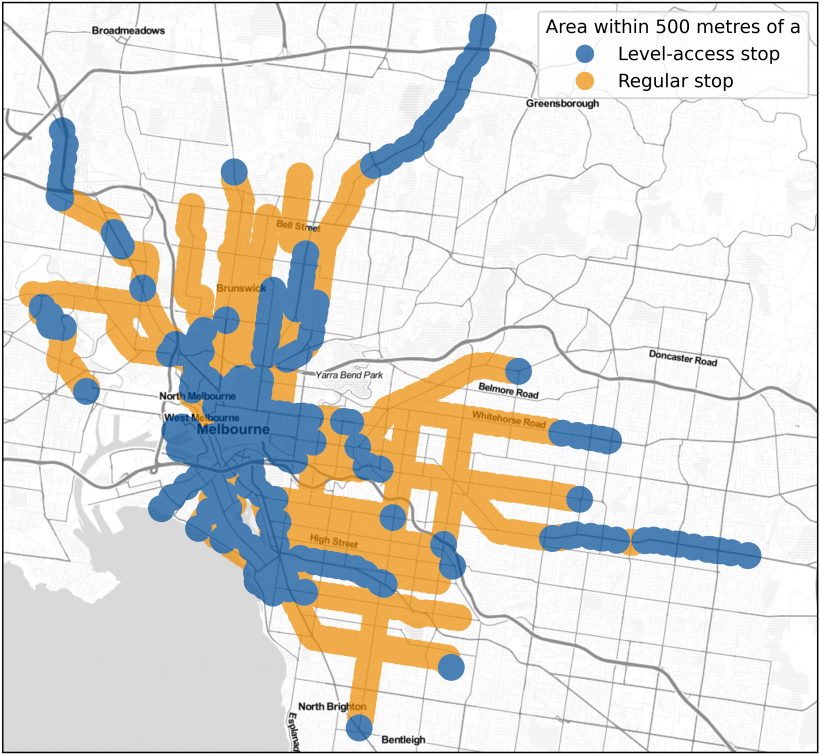
Source: VAGO, using data from DoT, YT and ABS.
Our analysis identified that the central areas of Melbourne have higher population density rates and also have a high percentage of level-access stops.
Further interpretation of the ABS population data overlay showed that:
- 7.5 per cent of Melbourne’s population (367 855 people) are within 500 metres of a non-level-access tram stop
- 50 per cent of that group (184 185 people) is not within 500 meters of a level access stop, so they have no practical choice about which tram stop to use.
We used the ABS estimate that 17 per cent of the population lives with disability (which may or may not involve a mobility impairment) to estimate that there could be 62 535 people living with disability within 500 metres of a currently non-level-access stop.
DoT has estimated in its own documents that a full network-wide upgrade of tram stops to level-access would cost at least $2 billion.
Based on this, the cost of delivering accessibility (via the practical enabler of a level access stop) for a person living with disability within 500 metres of a tram stop is $1 066 a head per year for 30 years. We have conservatively estimated 30 years as the useful life of an upgraded level-access tram stop. However, other tram infrastructure is often in use for up to 50 years.
If all potential tram users within 500 metres of an upgraded stop (that is, 367 855 people) are included in the calculation, the cost is $181 per person per year for 30 years. This assumes that a level-access stop can be used by all people in all stages of life with all degrees of mobility.
These estimates are illustrative only and do not take into account any potential benefits from a wider program of tram infrastructure investment to achieve DSAPT compliance. A description of the data and methods we used to produce this analysis is in Appendix E.
DoT is not able to assess or enumerate potential costs and benefits because it has not done a comprehensive cost-benefit analysis of the full rectification (including opportunities for rationalisation) of the remaining tram stops that need upgrading to level access and DSAPT compliance.
In addition to identifying construction costs, such an analysis could also calculate other potential societal benefits from rolling out accessible tram infrastructure, such as:
- the stimulatory effect on the labour market from increased construction activity
- improved passenger and road network safety
- improved tram speeds due to improved boarding and alighting
- greater participation in the economy and community of people living with mobility challenges
- impacts on economic externalities like congestion and pollution.
2.4 Capture and analysis of compliance data
The database that DoT and YT use to record the tram network’s compliance is incomplete and not fully reliable. As a result, the database cannot provide DoT or YT with an accurate status of the network’s level of compliance with DDA and DSAPT requirements.
Sourcing network compliance data
Since 2016, DoT and YT have recorded information about the tram network’s compliance with DSAPT requirements in a database. DoT’s intent when developing this database was to enable network operators to maintain and update accessibility and compliance data.
Part 21 of DSAPT relates to Controls. This covers requirements for passenger-operated devices to open and close manual and power-assisted doors on trams. It also specifies requirements for the location of these devices on the tram and a requirement for a signal device that complies with Australian standards.
The database holds information about each tram stop on the network, including its dimensions, number of accessible entrances, and features of the surrounding environment, such as the dimensions of an adjacent roadway. An external reviewer captures and uploads tram stop data into the system.
DoT’s database can only record data against the DSAPT parts that were included in the system when the database was created. It does not record data against parts that DoT considered would require specialist testing, such as 'Lighting', or which DoT considered to be minor, such as ‛Controls’. Further, the data is incomplete because DoT and YT have only included records for those DSAPT parts that DoT and YT have had independently reviewed.
YT’s reviewer has not done a full check of all tram stops on the network since 2017. YT states that the purpose of the 2017 review was to record every stop’s dimensions. Since then, YT only commissions an independent review and updates the database when it upgrades a tram stop. DoT last commissioned a technical review in 2014 of the compliance of tram stops but has not done a similar review for trams.
Database limitations
Although DoT’s database is capable of capturing basic data, there are limitations that impact its completeness, accuracy, and reliability:
|
DoT's database ... |
Because ... |
For example ... |
|
Does not capture all accessibility features required by DSAPT so it cannot give an accurate percentage of total network compliance |
Some DSAPT requirements were not included when the database was created because specialist/technical services were needed to make an assessment. |
Lighting requirements |
|
Cannot show the additional work needed to make a stop fully accessible—manual analysis is required |
The database cannot pinpoint the specific feature that makes a stop inaccessible. |
If 9.5 out of 10 accessibility features at a stop are compliant the system does not record the missing features required to make a fully accessible stop |
|
Does not capture tram data (despite having the capability) |
DoT and YT have not reviewed tram compliance with DSAPT requirements |
DoT and YT have no data on how many trams in the fleet have correct accessibility signage as required by DSAPT |
While the database can show the compliance gap, this is a manual exercise and a true gap analysis would require further interpretation.
Upgrading the compliance database
Since 2018, DoT and YT have recognised the impact of DoT's database limitations. When identifying enhancements to the system, DoT had four early priorities:
- the ability to generate reports that calculate compliance by percentage for each tram stop
- the ability to retrieve accessibility attributes for tram stops and for manual input of attributes that are not audited
- enabling editing of audit questions and compliance values on the database
- improvements to functionality to allow archiving of superseded stops to demonstrate improvements over time.
In July 2019, DoT engaged an external consultant to enhance the database’s features. The scope of this work is underway and incorporates the four priorities above.
|
The project would ... |
This would allow ... |
Current status (August 2020) ... |
|
Alter the current methodology |
The creation of new compliance reports that retrieve and present the audit data differently |
Complete |
|
Add the ability to report on network compliance separately for metropolitan and regional services (the database is also used by Melbourne’s train providers) |
For more targeted reporting and tracking in real time. |
Complete |
|
Include the capability to produce individual compliance reports for each tram stop |
Complete |
|
|
Ensure that only the most recent stop and individual audits are included for reporting |
The removal of duplication and previous inaccuracies with compliance calculations |
Only completed for train stations. This feature for tram stops is not yet complete |
|
Update the database’s training manual |
Users to learn the new process for adding new audits, re-auditing and running reports |
Not yet complete |
According to the contract, the completion date for this work was originally September 2019. However, due to budget constraints as well as additional work identified, the work was still ongoing as of September 2020.
3. Planning to make the tram network more accessible
Conclusion
DoT does not have conclusive plans for how it will create an accessible tram network, 18 years after DSAPT was established.
DoT is developing a strategy to rollout level-access stops, but the strategy will not be complete until June 2021. This means DoT will only have 18 months to upgrade up to 1 215 stops to level access at an estimated cost of at least $2 billion, although this does not guarantee full DSAPT compliance.
There is also no guarantee that these works, which are required by legislation, will be done. At present, DoT has no funding to build enough level-access stops or low-floor trams. DoT’s failure to fulfil legislative requirements and deliver accessible tram services means it is not fully supporting all members of society to access Melbourne’s tram network on a non-discriminatory basis.
This chapter discusses:
3.1 Public transport accessibility action plans
Accessible Public Transport in Victoria Action Plan 2013–17
In 2013, a DoT predecessor agency published the Accessible Public Transport in Victoria Action Plan 2013–17. Its key focus was to set up outcomes that Victorian transport franchisees and operators, such as YT, could incorporate into their own business goals. DoT initially intended to report on its progress annually, but changes to government priorities and funding meant this did not occur.
In early 2020, the former Minister for Public Transport approved the Accessible Public Transport in Victoria Action Plan 2020–24. It is not yet published as DoT has resubmitted the 2020 Action Plan to the new minister. The new Action Plan identifies some progress, including:
Travellers Aid provides a range of services to make travelling on public transport easier and more convenient. It offers services such as mobility equipment hire, emergency relief for travellers and a ‛companion service‘ to get travellers to and from appointments. Travellers Aid is based at Southern Cross and Flinders Street stations and many of its services are free.
- an improved partnership with Travellers Aid
- implementing accessibility training and programs to increase awareness for DoT and YT staff
- appointing Public Transport Access Committee members in 2016 to provide independent advice to the Minister for Public Transport and DoT about accessibility issues
- delivery of 100 low-floor trams (20 per cent of all trams on the network)
- installation of audio-visual passenger information on all A and C-Class trams.
The new action plan is silent on progress made on DSAPT compliance.
DoT‘s 2013 action plan asserts that applying DSAPT requirements to public transport does not necessarily make a person‘s overall public transport journey accessible. However, it also states that as a minimum, the outcomes and priorities set out in the action plan would achieve compliance with DSAPT. Figure 3A shows the priorities of DoT‘s 2013 action plan.
FIGURE 3A: Priorities of DoT‘s 2013 action plan

Source: DoT‘s Accessible Public Transport in Victoria Action Plan 2013–17.
DoT‘s 2013 action plan was accompanied by an implementation plan detailing actions it planned to deliver. Actions relevant to the tram network included:
- ensuring newly procured trams incorporate accessibility and are DSAPT compliant
- increasing the number of level-access tram stops on routes where low-floor trams are deployed
- continuing to have quarterly meetings with the Public Transport Access Committee.
DoT’s plan did not say when it would complete these actions, nor did it say what resources or activities might be required to fulfil these actions.
Accessible Public Transport in Victoria Action Plan 2020–24
As with its 2013 action plan, DoT takes a whole-of-journey user-focused approach in its 2020 action plan, rather than focusing on accessibility compliance.
|
DoT's 2020 action plan says … |
but … |
|
DoT wants to continue building level access stops
|
DoT does not give targets for how many stops it will upgrade per year |
|
DoT does not say how it will achieve the legislated infrastructure target of 31 December 2022 |
|
|
The government has obligations under DDA and EOA, and the legislation protects people with disability
|
DoT is silent on how it will implement DSAPT across the tram network |
|
the action plan does not acknowledge that at a minimum, priorities and outcomes should achieve DDA and DSAPT compliance. |
DDA states that action plans may be prepared and implemented by public transport providers and operators. DSAPT allows for the contents of an action plan as a relevant consideration if AHRC is determining whether a public transport operator or provider is experiencing unjustifiable hardship.
Without a specific connection to the required DSAPT actions and firm dates for the implementation of DSAPT compliance, DoT’s 2020 action plan lacks a clear commitment to meeting these important legislated requirements to make tram services accessible.
DoT advised us of its view that noncompliance with DSAPT’s requirements does not necessarily mean that a tram stop or low-floor tram is not accessible. DoT noted that depending on the level of noncompliance, a person with disability may still be able to access parts of the tram network.
Figure 3B illustrates the importance of making accessibility plans and strategies with people with disability in mind.
FIGURE 3B: Case study—Jo's story
Jo* has partial vision. Jo is independent and regularly catches public transport, particularly trams.
For Jo, visible signage on the front of trams and at trams stops is a constant concern. This is a heightened issue at night, when Jo’s visibility is particularly low.
Although Jo relies on audible announcements on the tram, these are not always present or synchronised to the correct tram stop. Due to this, Jo has to do detailed research prior to travelling to make sure Jo boards and alights the correct tram and stop. With Jo’s limited vision, Jo states that just having bigger text on tram stop signs would significantly improve Jo’s journey and confidence travelling on the tram network.
Jo describes experiencing issues on the tram network daily. On one occasion, the tram that Jo was on diverted from its original route. The tram made no audible announcements informing passengers of this change or where the tram was going. This made Jo’s journey very difficult with Jo’s only option to remain on the tram. However, this meant it took Jo far longer to get home.
Jo believes that low-floor trams and level-access stops are not enough. For Jo, the tram design process prioritises roads and traffic, and not enough thought is given to people with disability. Jo strongly believes that accessibility should apply to all users of the tram network.
While Jo acknowledges the significant spend needed to make the tram network accessible, Jo believes that this would be money well spent.
In Jo’s own words: ‛transport means independence’.
*For privacy purposes, we have not used the real names of case study subjects.
Source: Case study interview conducted by VAGO.
YT’s accessibility action plan
YT’s franchise agreement requires it to develop an accessibility action plan and accessibility implementation plan every three years. Together, these plans outline the work that YT needs to do to improve the tram network‘s accessibility and to achieve DDA and DSAPT compliance.
Under the MR4 franchise agreement, YT’s accessibility action plan must:
- comply with DDA
- be consistent with DSAPT and DoT’s action plan
- address its obligations and responsibilities relating to DDA and DSAPT under the franchise agreement.
YT’s implementation plan must set out the specific work and activities YT will undertake to meet the priorities in its action plan.
In 2019, YT produced the Yarra Trams Accessibility Action Plan 2019–2022 and Accessibility Implementation Plan. YT aims to have a tram network that is inclusive and accessible for all.
Figure 3C shows the priorities of YT’s action plan.
FIGURE 3C: YT’s action plan priorities

Source: Yarra Trams Accessibility Action Plan 2019–2022.
YT‘s current action plan specifically aligns with DoT’s 2013 action plan. DoT’s approved but unpublished 2020 action plan has similar priorities to its previous plan, and so it is unlikely that YT will need to amend its current plan.
The Communication Access Symbol was launched in 2011 to let people know that a place or service is communication accessible. To be allowed to display the Communication Access Symbol, organisations need to be assessed and meet minimum standards for communication. Those standards include providing staff with knowledge and skills in how to communicate with someone with disability respectfully and effectively, providing accessible environments for people who use wheelchairs, using easy-to-see signage, and providing information in different accessible formats.
YT’s action plan has initiatives to achieve these priorities, including:
- becoming accredited with the Communication Access Symbol, which was achieved in November 2019
- continuing quarterly engagement with the YT Accessibility Reference Group, whose membership includes representatives from disability and advocacy bodies
- engaging with stakeholders and local governments to identify opportunities for network improvement
- providing advice to the state about the tram network’s accessibility.
YT’s implementation plan expands on each action plan initiative, identifying the YT groups that are responsible for delivery as well as specifying target completion years.
YT's responsibilities do not extend to making significant capital upgrades to the tram network, such as funding works to make stops level access or procuring low-floor trams.
This is because funding for capital upgrades, beyond ‛like-for-like’ renewal and maintenance, which is earmarked in the MR4 franchise agreements, is DoT’s responsibility.
3.2 Advice to DoT from YT
YT is obligated under MR4 to provide advice to DoT about:
- what the network requires to achieve DDA and DSAPT compliance
- YT’s assessments of how best to meet the requirements, including how much it might cost.
YT has provided this advice to DoT.
Costed options report for expiry of DSAPT exemption period
In 2019, YT provided DoT with a report called Exemption Expiry Costed Options. The report details what DoT and YT need to do to achieve DDA and DSAPT compliance following the expiry of any DSAPT exemptions they hold.
This costed options report fulfilled YT’s contractual obligation to provide advice to DoT about the cost of meeting DSAPT obligations at the expiry of the exemption from AHRC, which was 30 September 2020.
YT’s costed options report details what percentage of the trams and tram infrastructure are not compliant with the relevant exempted DSAPT parts. The report gives DoT options for steps to rectify noncompliance with DSAPT and a cost benefit analysis for each option.
The costed options report estimates that the costs to cover the previous exemptions relating to infrastructure is at least $137 million.
YT also advised DoT that to comply with Part 2.6 of DSAPT, DoT would need to replace 271 high-floor trams, which YT estimated would cost $1.68 billion. This does not include additional costs to build supporting infrastructure for the new trams, such as traction power substations, depots or stabling tracks.
DoT has not yet decided which suggested steps from YT’s costed options report it will pursue in future business cases it prepares for the government’s consideration, if any. DoT has briefed the Minister for Public Transport on the contents and cost implications of YT’s costed options report.
YT’s enhanced renewal strategy
MR4 requires YT to have a Franchise Infrastructure Management Plan. This is a seven year plan that outlines how YT will maintain existing tram infrastructure. It allows for network maintenance on a like-for-like basis where no infrastructure improvement is made.
In 2018, YT identified opportunities in the Franchise Infrastructure Management Plan between 2019 and 2022 where YT could enhance planned track maintenance to include accessibility works, such as concurrent delivery of DSAPT-compliant level access stops, with additional funding and approval from DoT.
These opportunities, described as ‛enhanced renewals’, would allow YT to improve existing infrastructure to meet DSAPT requirements.
Completing enhanced renewals alongside routine maintenance offers a range of benefits, including cost savings, less disruption to the community, and futureproofing of tram routes (by moving tracks to make room for future level-access stops) to enable compliance with DDA and DSAPT requirements.
YT presented the enhanced renewals proposal to DoT and identified that with $23 million in additional funding between 2019 and 2022, it could:
- build 18 pairs of level-access stops
- reduce risks of vehicle–tram collisions
- improve tram travel times.
YT’s analysis also showed that it would cost DoT another $17 million over YT’s estimate if these works were not done concurrently.
Ultimately, the proposed enhanced renewals offered by YT were not funded by DoT. It is unclear why funding was not pursued in DoT’s business case and capital budget process.
3.3 Plans for the tram network
In 2019, DoT produced an internal overarching plan that lays out goals for the tram network over the next 30 years. The goals mainly relate to improving passenger capacity, safety and accessibility and connecting more people to more parts of Melbourne.
This is the first time that a plan for the tram network has been circulated and finalised within DoT. Having an overarching tram plan means that different branches within DoT can create a cohesive series of integrated strategies.
DoT is planning to develop the tram network to accommodate Melbourne’s growing population and changing transport needs. However, the plan is silent on how and when DoT will achieve legislative compliance for accessible tram infrastructure.
While an overarching plan for the tram network is an important step in improving the network, these plans have not been published.
DoT officers informed us that in their view, infrastructure upgrades are more efficiently implemented when there is early consultation and planning discussions with local councils and community members who will be directly affected by network changes. However, we have not seen evidence to show that the plan has been made available to relevant experts and external stakeholders or the public for feedback.
DoT is working on supplementary plans for stop and tram upgrades and network configuration which will align with the goals of the overarching plan for the tram network.
The SRS discussed in this section is one example of a supplementary plan. Another supplementary plan is the Trains, Trams, Jobs 2015−2025 Victorian Rolling Stock Strategy (Rolling Stock Strategy). DoT is preparing an updated rolling stock strategy to account for the development of a new type of low-floor tram.
3.4 Incorporating DDA and DSAPT requirements into planning
Although DoT’s plans acknowledge obligations under DDA and DSAPT in general terms, planning documents lack specific detail, such as cost or time frames, on how it will implement these legislative requirements.
For example, DoT’s internal overarching plan for the tram network, which sets out the goals for the tram network over the next 30 years, does not specify how or when DoT intends to implement DDA and DSAPT requirements for tram stop upgrades.
YT has a good practice guide titled Future of the Stop for urban planners, designers, transport planners and traffic engineers to use when they are designing and placing accessible tram stops in a street context.
YT also has a Tram Stop Platform Design Guide that outlines technical design requirements as outlined by DSAPT and other applicable regulations such as VicRoads guidelines.
Stakeholder involvement
When developing strategies, guidance and plans for tram stops, DoT and YT consulted with a range of stakeholders. Forums were in place to receive regular insights on the accessibility needs of the community. However, we did not see evidence that feedback from community consultation had any impact on the planning and phasing of upgrades.
DoT told us that the government’s funding priorities determine the amount of funds available to upgrade tram infrastructure to meet community needs. As a result, DoT’s ability to target priority needs or areas on the network has been limited by the funding made available by various state Budgets over time.
3.5 Strategies for tram infrastructure upgrades
DoT is developing a strategy for tram stop upgrades called the SRS. The strategy is informed by the draft Stop Prioritisation Framework (SPF), a tool used by DoT since 2016 to prioritise stop upgrades.
|
DoT is working on … |
Because … |
|
SRS |
There is no plan or strategy for how and when tram stops will be upgraded to level access resulting in:
|
|
Updating the SPF |
It will inform the order in which stops should be upgraded. The order will then be incorporated into the SRS |
The Stop Rollout Strategy
The SRS was funded in the 2019–20 state Budget, building on the existing SPF. The $3.1 million project is also investigating options for streamlining the design and construction of accessible tram stops and prioritising tram stop upgrades across the network.
The SRS is expected to give different options to the government to help it choose how and when it will upgrade the remaining non-level-access tram stops on the network. The different options will show the sequence, timelines and costs required to deliver the stop upgrades.
This approach aims to give the government flexibility to decide how to upgrade the remaining non-accessible tram stops based on funding availability and timing.
DoT does not expect to complete the SRS until June 2021. If completed by then, DoT will have 18 months to upgrade up to 1 215 tram stops if it is to achieve the legislated 31 December 2022 DSAPT infrastructure target.
Irrespective of this, delivery of any stops prioritised by the SRS is subject to the government approving funding for their construction.
Figure 3D illustrates the importance of designing a stop with all users in mind.
FIGURE 3D: Case study—Nic's story
Nic* is an elite athlete and former Paralympian. Nic uses a manual wheelchair and regularly catches the tram..
Nic reflects that growing up with disability meant that Nic was constantly ‛trying not to be an inconvenience to society’.
Prior to the upgrades on Nic’s preferred tram route, Nic sometimes needed to be lifted onto a tram with another person’s assistance. The super stop upgrades on Nic’s route have significantly improved Nic’s ability to independently travel on trams. The route Nic uses has many more level access stops than other routes, but travelling in most other places continues to be an uncertain and worrying experience for Nic.
Nic acknowledges that as a former Paralympian, Nic is probably fitter, stronger and more agile than a typical wheelchair user. Where a stop is not fully level access, Nic has the physical strength and dexterity to get out of the wheelchair, crawl onto the tram and pull the wheelchair up onto the tram.
Although Nic ‛hates to do this’ because it is difficult, people stare, and it makes Nic feel more disabled, Nic must do it if there is no level-access stop.
Nic believes that many people using wheelchairs do not use trams at all because they cannot physically get on a tram in any practical way.
Nic believes that level surfaces, adequate parking space on the tram for a mobility aid, and lower placed stop buttons are useful features on a tram for wheelchair users. However, Nic does not think that these features are enough, and full accessibility cannot be achieved without applying all of the DSAPT requirements.
Nic believes that accommodating a person with a wheelchair should not be seen as just an expense to avoid or minimise, as this approach encourages narrow, cost-focused solutions.
For Nic, a ‛universal design approach’ increases the value of an upgrade because this design approach allows more people to access the tram network irrespective of their abilities.
Nic does not think that accessibility is just about wheelchair users. Nic views accessibility as helping all people at some point in their lives, whether they have prams, crutches, cannot hear audio announcements or cannot read small writing.
According to Nic, designing for all makes the experience better for everyone.
*For privacy purposes, we have not used the real names of case study subjects.
Source: Case study interview conducted by VAGO.
The Stop Prioritisation Framework
The SRS project will also update DoT’s SPF. The proposed updates are related to the collection and management of data in the SPF, rather than the way in which the framework prioritises stops to be reviewed or changed.
It is not possible to upgrade all relevant tram stops at the same time without significant traffic disruption. Therefore, the SPF ranks tram stops to identify which are the most important, based on user and network needs. The SPF can also manually rank an identified bundle of stops along the same route.
While the stop rankings produced by the SPF help to inform DoT’s funding pipeline, it is not the only factor by which stops are included in business cases nor why they are funded.
DoT uses the SPF as a broader network planning tool that takes into account accessibility as well as planned construction or network safety. It does not have any specific connections with DDA requirements or DSAPT milestones and targets.
How the SPF works
The SPF considers a stop’s broad accessibility characteristics. For example, it records whether the stop is on a route serviced by low-floor trams or if there is any nearby alternative accessible transport, such as a ‛kneeling’ bus or an accessible train station.
SPF rankings score tram stops against data variables or subcategories. DoT and its Accessibility Working Group, which is made up of DoT and YT representatives, decide on these variables and their weighting or relative importance.
Variables include factors like a tram stop’s proximity to a school, how many casualty crashes have occurred at a stop, or how many people use a stop.
The subcategories fall under five overarching categories—safety, planning and delivery, movement, place and accessibility. Together the overarching categories describe what a stop upgrade might mean for the network in terms of:
- improving the safety or capacity of a stop
- making a location reachable for a greater number of people
- making a route or stop accessible for people with disability
- assisting in starting or contributing to a series of upgrades for trams or other close-by transport networks.
DoT calculates final scores for stops and stop bundles using category weightings and subcategory weightings and criteria.
Figure 3E shows the main categories and their weightings.
FIGURE 3E: SPF main categories and their weightings
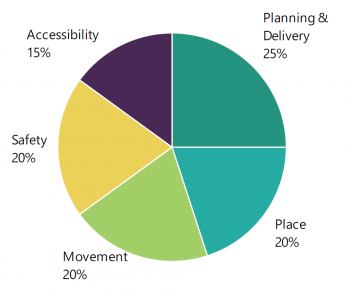
Source: DoT’s SPF.
There are 21 subcategories, shown in Figure 3F.
FIGURE 3F: Main categories and subcategories in the SPF
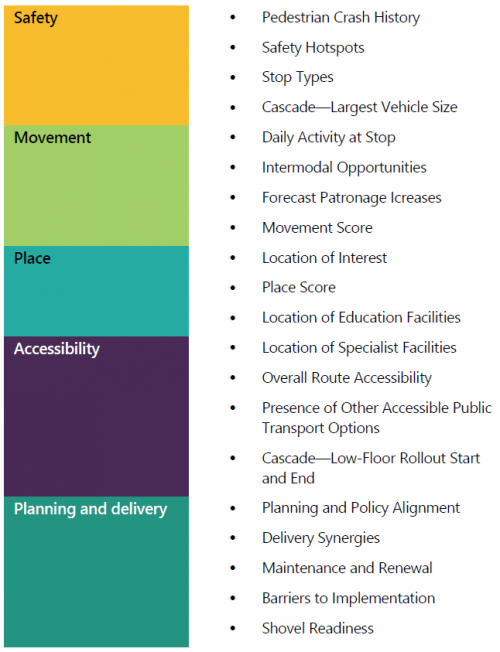
Source: DoT’s SPF.
Tram stops that are not yet upgraded are ranked in the following way:
- Individual stops receive a score for each subcategory based on the subcategory’s unique criteria.
- Within each category, a tram stop’s scores are averaged out based on the subcategory weighting to give a total category score for the stop.
- A stop’s total category scores are then balanced out based on category weightings. This gives a final score for a tram stop.
A tram stop’s score will affect whether it is recommended as a priority for an upgrade or not.
Stop bundles are manually identified groups of stops, either on the same tram route or road, that could be upgraded at the same time.
The SPF also ranks stops into bundles. Stop bundles can include stops that are low priority individually but are located next to or in between highly ranked stops, meaning they are given higher priority as a bundle. Stop bundles, once identified, are ranked in the same way that individual stops are ranked.
SPF data quality issues
The SPF is underpinned by data relating to the tram network that is sourced from DoT, YT, and the Department of Environment, Land, Water and Planning. The SPF does not specify data sources, and there is no assurance on how and when DoT and YT collect or curate the data.
The SPF uses data from August 2018 and it is in scope to be updated as part of the SRS. Categories and weightings that define how stops are ultimately prioritised or ranked will also be reassessed as a part of the SRS.
SPF main categories and weightings
The SPF’s functionality relies on the main categories and their weightings. There are two main concerns with this:
- The main categories are vague and do not have detailed attributes.
- Category weightings can be easily changed.
The five main categories are broadly defined and give unclear reasons why certain stops should be prioritised over others.
Category weightings have a direct impact on which tram stops are identified as highest priority. However, there are no controls over category weightings, which means any person with access to the framework file could change category weightings.
There is no documented rationale by which DoT sets the weighting and no controls or governance over changes to the weightings. As a result, the SPF lacks transparency and accountability for any changes that are made.
This means that the logic of the model and its outputs are, in effect, set by the person who sets the category weightings. There is no trail of changes made over time and no quality assurance done by an independent person of the data nor the model.
If the SPF is intended to be used as a decision support tool, there needs to be controls within the framework to track changes to the model and the reason for any changes.
Underlying variables and their weighted criteria
The subcategories and their weighted criteria have two weaknesses:
- Factors may be double counted because some subcategories overlap (see examples below).
- Some subcategories give equal weighting to different factors where equal weightings for those factors appear unreasonable.
This can result in final category weightings giving greater consideration to small issues, which can result in a stop’s unwarranted prioritisation.
For example, under the Safety category, the Safety Hotspots and Pedestrian Crash History subcategories overlap or measure related statistics. A tram stop identified as a safety hotspot includes a risk of collision and pedestrian injuries or fatalities. Pedestrian crash history counts times where no injury, some injury, a serious injury or a fatality has occurred at a tram stop.
Therefore, a collision resulting in injury at a tram stop will be counted under Pedestrian Crash History and the stop will be reclassified as a safety hotspot if it was not already. This results in the framework double counting a single factor. Double counting undermines the integrity of the subcategory weightings, which exist to highlight the importance of a subcategory.
Figure 3G shows the relationship between the Safety Hotspot and Pedestrian Crash History subcategories.
FIGURE 3G: Relationship between two subcategories in the SPF
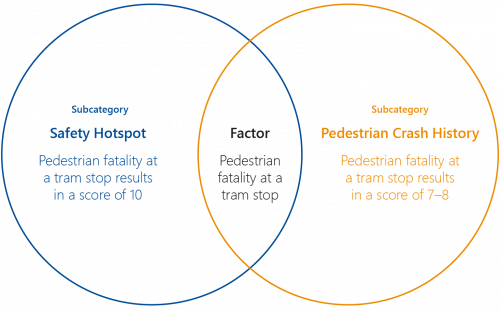
Source: VAGO, using information from the SPF.
Subcategories with equal weightings, where the application of equal weightings appears unreasonable, conflate small issues with serious ones.
For example, under the Pedestrian Crash History subcategory, a pedestrian crash that resulted in six minor injuries would be considered more serious than one that resulted in four serious injuries.
This outcome is caused by the criteria weightings and provides an inaccurate perspective of the safety of one stop over another. Thus, the final stop score is inaccurate and not reliable.
The SPF in practice
DoT planned to upgrade 24 level-access stops in 2019–20. This accounts for less than 2 per cent of the stops that need to be level access to ensure the tram network is accessible and DSAPT compliant by the 31 December 2022 legislated infrastructure target.
15 of the stops listed for upgrade were on Route 96, which will be Victoria’s first fully accessible tram route when the rollout is completed. The upgraded stops were delivered in January 2020 except for Stop 133 in Fitzroy Street, St Kilda, which is the only remaining non-accessible stop along the tram route. The stops on Route 96 were not identified by current or historic SPF priority lists because Route 96 upgrades were planned and commenced before the development of the SPF in 2013.
Some planned stops in 2019–20 may not be identifiable on the current SPF because it only ranks unfunded non-accessible stops. However, even in historic versions of the SPF, stops planned for upgrade in 2019–20 had high rankings despite receiving lower overall scores in comparison to other stops ranked 10 or lower (see Figure 3H).
This demonstrates that the SPF is used inconsistently to assist tram stop prioritisation and does not provide transparency for changes made over time.
Figure 3H lists the stops planned for upgrade in 2019–20 and their ranking in the 2018 SPF.
FIGURE 3H: Stops planned for upgrade (2019–20) and their 2018 SPF ranking
| Planned stops | SPF ranking |
|---|---|
| 15 stops on Route 96 | N/A* |
| 4 stops on William Street | 1 |
| West Coburg Terminus (Route 58) | Unranked** |
| Two stops at Middle Park Primary School | 777 (out 1 215 stops) |
| Two stops at South Yarra Station | Unranked*** |
*Route 96 upgrades were planned and commenced before the development of the SPF.
**Ranked 1 in the 2017 version of the SPF. However, it received a lower overall score in 2017 than other stops.
***Ranked 25 in 2017 version of the SPF and funded in 2018−19.
Source: DoT, SPF.
3.6 Strategies for tram upgrades
In 2015, the government published the Rolling Stock Strategy which promised an immediate investment of $2 billion to build and maintain trains and trams in Victoria. DoT claims that since its publication, $4 billion has been invested in new rolling stock and support infrastructure including 47 VLocity trains, 24 X’Trapolis trains, 65 High Capacity Metro Trains, and 50 E-Class trams.
The Rolling Stock Strategy planned to have 240 new low-floor trams on the network by 2025. There are currently 86 E-Class (low-floor) trams on the network, with the fleet to grow to 100 by 2021.
Figure 3I shows a projected rate of replacement of the existing 2015 high-floor tram fleet with new low-floor trams. Based on actual deliveries of low-floor trams (shown in Figure 3J), DoT will be behind schedule by 30 trams in 2021 with 100 E-Class trams in service versus the target of 130.
FIGURE 3I: Projected tram replacement 2015–25 of 2015 existing fleet by new fleet
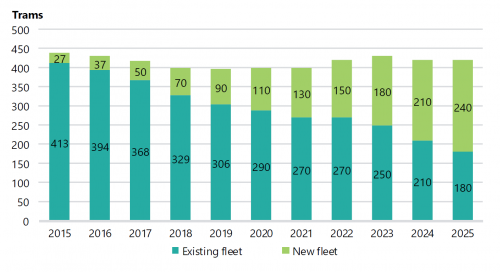
Source: DoT’s Rolling Stock Strategy.
Figure 3J shows the actual replacement rate of high-floor trams by E-Class trams.
Although the projection in 3I expected the fleet to have 440 trams in 2015, due to operational needs, the actual overall fleet was 472 and increased to 492 in 2020 (not including W-Class trams).
This fleet increase impacts the total number of trams that will need to be replaced to meet DSAPT targets, as well as maintain or grow services. The government has not funded any new tram purchases since 2019.
FIGURE 3J: Actual tram replacement by E-Class trams
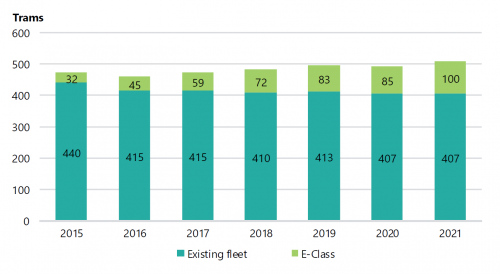
Source: VAGO, using data from YT.
DoT has not replaced as many high-floor trams as intended when it introduced the E Class trams to the network in 2013. Originally, DoT planned to replace 1.6 high floor trams for each E-Class tram. However, DoT did not achieve this replacement rate because of significant patronage growth, which it did not foresee.
The tram replacement rate is now close to one for one, to allow YT to maintain service frequencies on the network.
Apart from patronage growth, increasing traffic congestion has also had an impact. As cars and trucks use the shared road space, tram speeds are directly affected by road congestion, thus requiring a larger fleet to maintain service frequency.
DoT advised us that it intends to request funding from the government to purchase additional low-floor trams in the 2020–21 Budget. The Budget has been delayed due to the COVID-19 pandemic and is expected to be announced in late 2020.
Rolling Stock Strategy update
DoT is preparing an update to the 2015 Rolling Stock Strategy taking into account the planned purchase of a new type of low-floor tram known as the Next Generation Tram.
DoT demonstrated to us how it plans to replace all high-floor trams with low-floor trams by the 31 December 2032 DSAPT deadline. However, achieving the target is contingent on DoT receiving sufficient funding to procure another 255 low-floor trams (E-Class or Next Generation Tram or a mixture of both) to replace 307 high floor trams on the network. DoT purchased 10 more E-Class trams in 2018 and received funding in 2019 for a further 10, which will bring the total to 100 for this type of tram.
DoT intends to replace 1.2 high-floor trams with one low-floor tram. This means that to achieve the 31 December 2032 DSAPT requirement, DoT will need to commission 28–30 low-floor trams per year from 2020 until 2029.
This rollout is ambitious and is more than double the current delivery achievements for the E-Class tram. The future delivery schedule also needs to allow for required manufacturing time frames plus any extra testing that may be required for a new class of tram like the Next Generation Tram.
Based on available evidence, it can take three to four years to manufacture and commission a new tram, although DoT believes this lead time could reduce after the selected manufacturer’s design and production processes have matured, allowing for a ramp up in the rate of delivery part way through a multi-year build program.
Next Generation Tram interactive design and procurement
An interactive design process is underway for the Next Generation Tram involving major rolling stock manufacturers who are working with DoT to design a tram that will be suitable for Melbourne’s network, as well as meet DSAPT requirements.
This design process intends to address technical issues experienced with the introduction of the E-Class trams, such as high-energy consumption, high vehicle weight, and variable floor heights. These issues have triggered significant network infrastructure costs along routes that have introduced the E-Class trams, such as the need to strengthen bridges and build new traction power substations.
DoT expects the first Next Generation Tram to be delivered on the tram network in 2024. This is contingent on DoT receiving funding for the Next Generation Tram procurement in the delayed 2020–21 Budget and choosing a successful manufacturer after the interactive design process.
If there are major delays in the interactive design process and Next Generation Tram procurement process, DoT has a fallback option to order up to 50 additional E-Class trams under the current E-Class tram manufacturing contract.
However, any additional E-Class purchases would also be contingent on DoT receiving additional funding from the government.
Appendix A. Submissions and comments
We have consulted with DoT and YT, and we considered their views when reaching our audit conclusions. As required by the Audit Act 1994, we gave a draft copy of this report, or relevant extracts, to those agencies and asked for their submissions and comments.
Responsibility for the accuracy, fairness and balance of those comments rests solely with the agency head.
Responses were received as follows:
Response provided by the Secretary, DoT
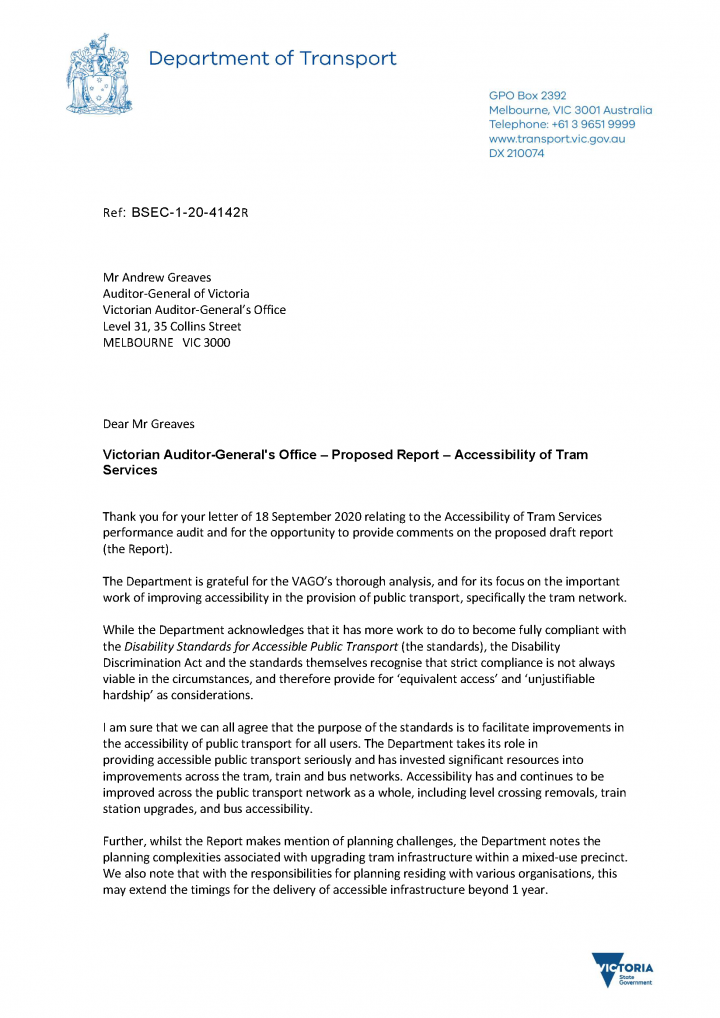
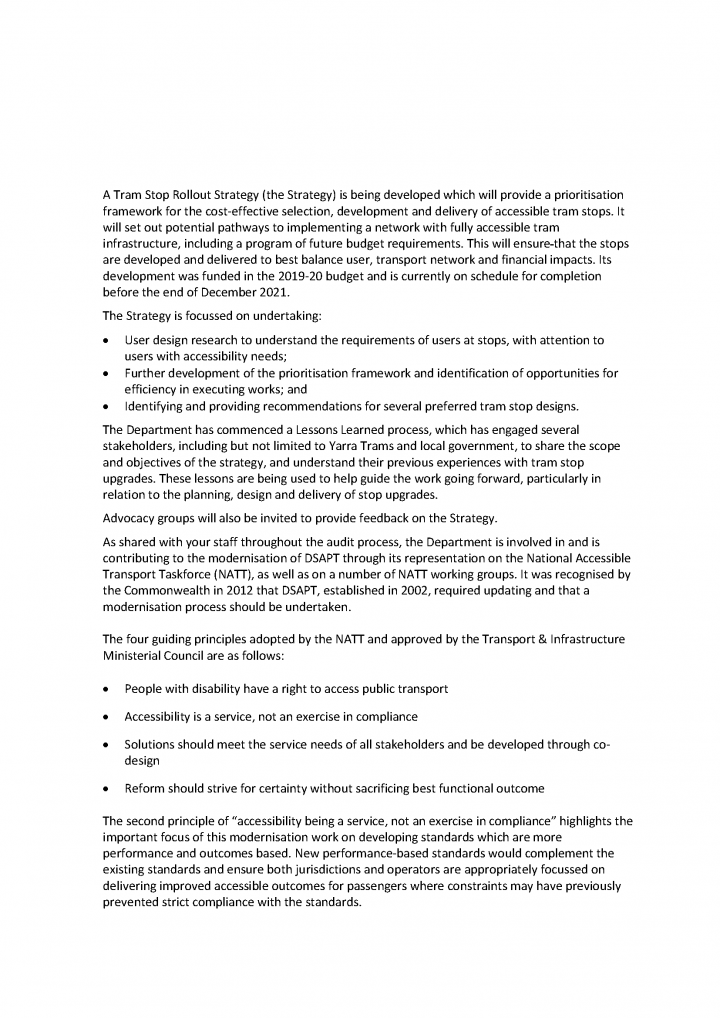
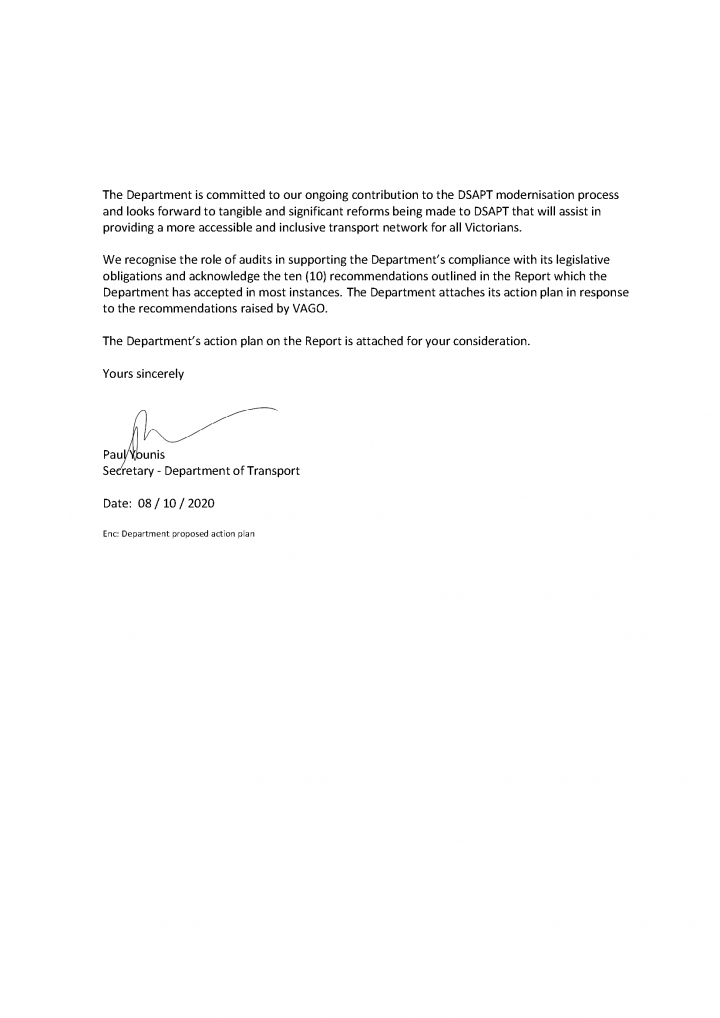
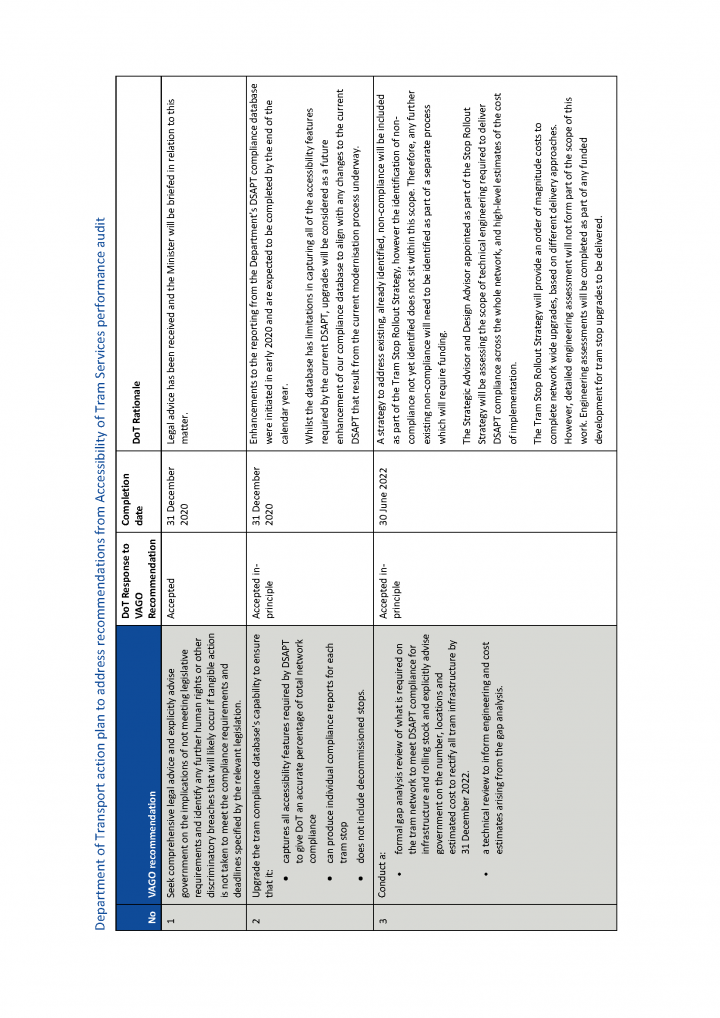
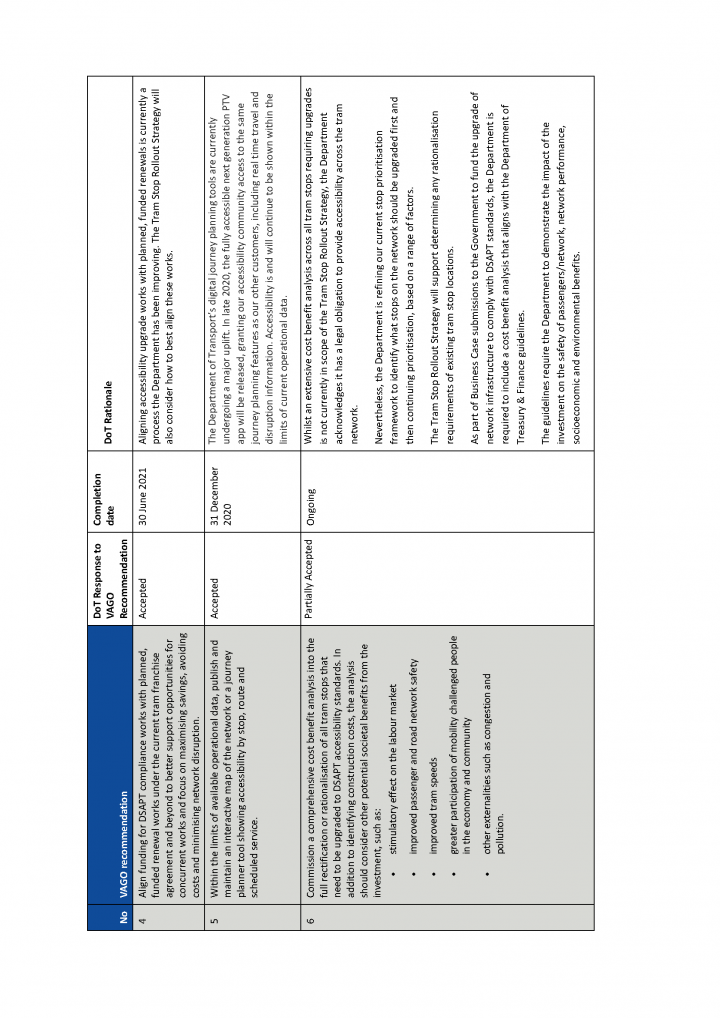
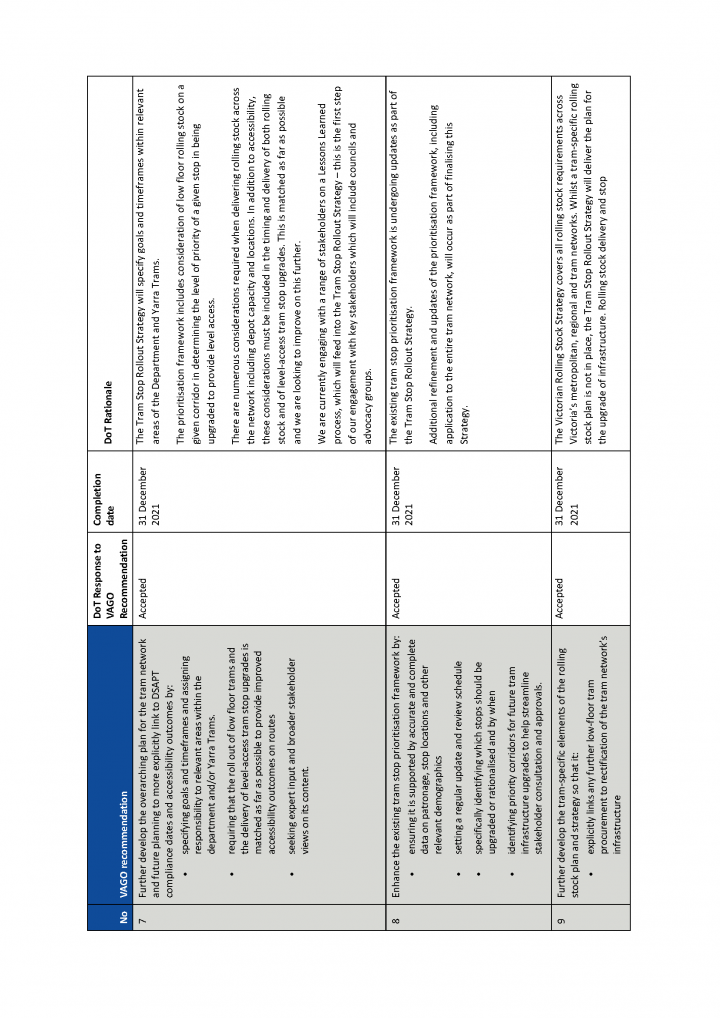
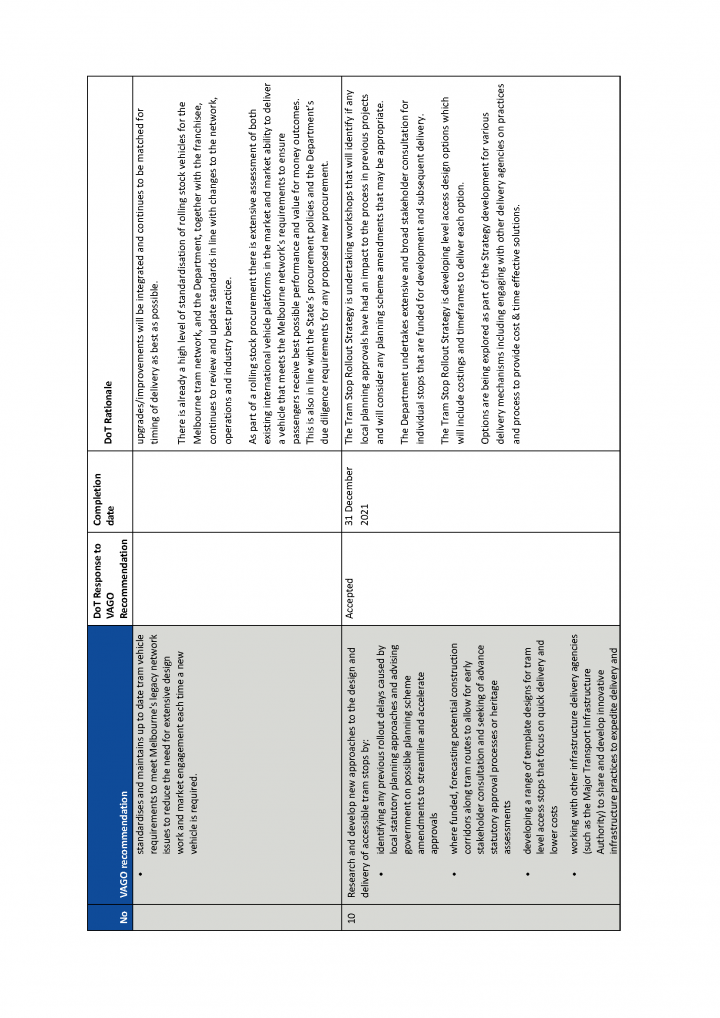
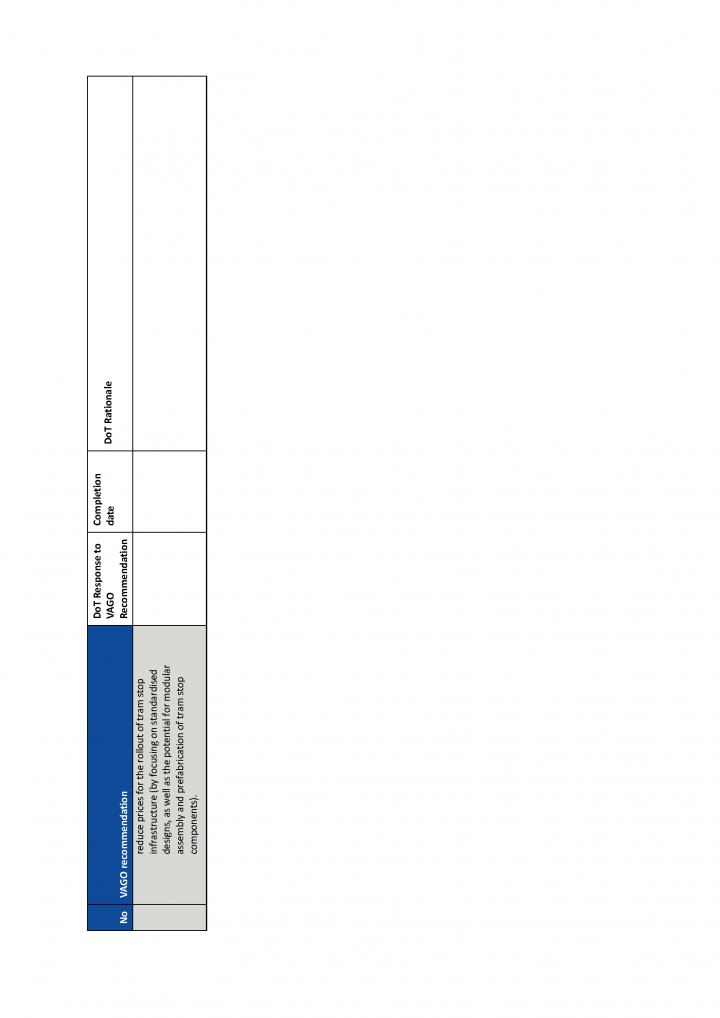
Response provided by the Chief Executive Officer, Yarra Trams
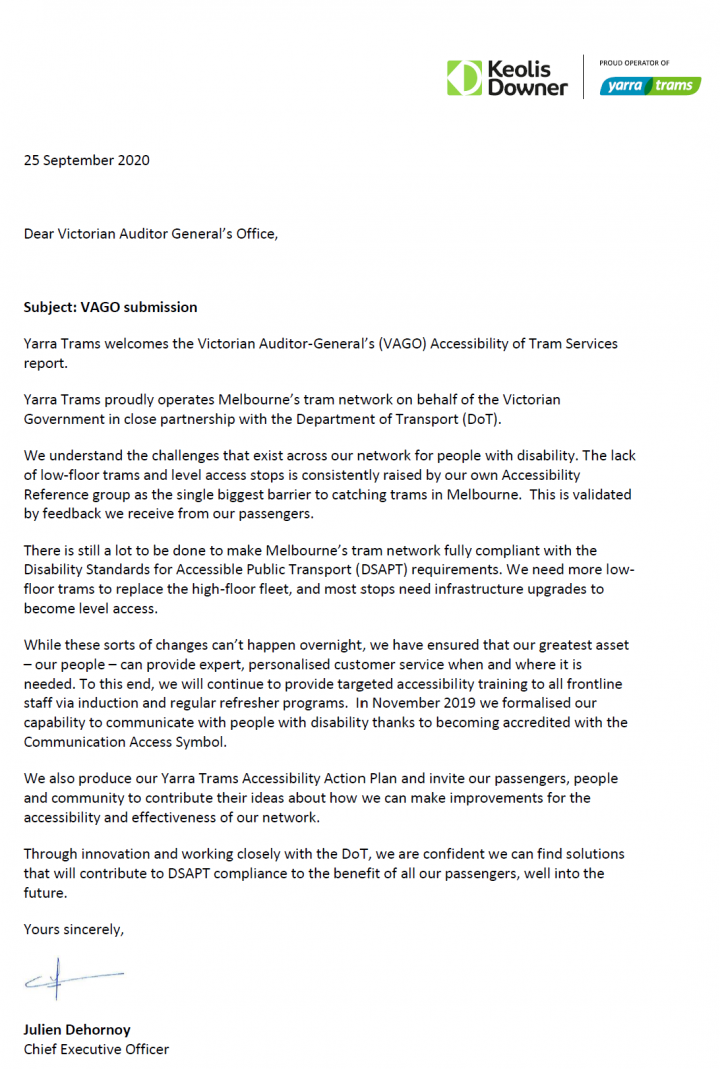
Appendix B. Acronyms, abbreviations and glossary
| Acronyms | |
|---|---|
| ABS | Australian Bureau of Statistics |
| AHRC | Australian Human Rights Commission |
| ARA | Australasian Rail Association |
| AVM | Automatic Vehicle Monitoring |
| DDA | Disability Discrimination Act 1992 |
| DoT | Department of Transport |
| DSAPT | Disability Standards for Accessible Public Transport 2002 |
| EOA | Equal Opportunity Act 2010 |
| MR4 | The Metropolitan Rail Franchising No.4, process, which developed the Franchise Agreement-Tram |
| PTV API | Public Transport Victoria application programming interface |
| SA1 | Statistical Area 1 |
| SPF | Stop Prioritisation Framework |
| SRS | Stop Rollout Strategy |
| VAGO | Victorian Auditor-General's Office |
| VEOHRC | Victorian Equal Opportunity and Human Rights Commission |
| YT | Yarra Trams |
| Abbreviations | |
|---|---|
| Rolling Stock Strategy | Trains, Trams and Jobs 2015-2025 Victorian Rolling Stock Strategy |
| The Whole Journey | The Whole Journey: A guide for thinking beyond compliance to create accessible public transport journeys |
Appendix C. Scope of this audit
| Who we audited | What we assessed | What the audit cost |
|---|---|---|
| DoT YT
|
The audit objective was to assess whether tram services are meeting the accessibility needs of passengers with mobility restrictions. We assessed whether:
|
The cost of this audit was $590 000.
|
Audit scope
The audit scope focused on the DSAPT requirements that apply to tram services with a particular focus on the accessibility needs of passengers with mobility restrictions.
The audit also reviewed the planning and implementation of tram network development strategies and the rollout of tram fleets by DoT and YT.
In terms of defining passengers with mobility restrictions, we identified three overlapping groups who could most benefit from improved accessibility of tram services:
- individuals living with disability, as defined in DDA
- individuals with general long-term mobility challenges, such as frail but active elderly passengers
- individuals with specific or short-term mobility challenges such as pregnant women, people with a temporary injury or parents with young children.
Our methods
Methods for this audit included:
- data analytics, such as simulation, mapping and visualisation of compliance progress to date as well as future challenges, across geographic locations and tram routes (more detail on this analysis approach is at Appendix E)
- review of relevant legislative, regulatory, contractual, policy and procedural documentation
- inspection of documents such as past, present and developing investment and project plans, policies and frameworks developed by public sector agencies and YT
- review of briefs and advice provided to government from public sector agencies
- review and analysis of performance data and related information from public sector agencies and YT
- case study research of user experiences for people with mobility restrictions using the tram network
- advice and data from broader stakeholders, such as experts, academics, peak bodies and professional organisations
- interviews with subject matter experts within DoT and YT on matters relating to tram planning, project management and accessibility policy.
We conducted our audit in accordance with the Audit Act 1994 and ASAE 3500 Performance Engagements.
We complied with the independence and other relevant ethical requirements related to assurance engagements.
Appendix D. Compliance against DSAPT requirements
Figure D1 shows DoT’s stated level of compliance with DSAPT requirements for existing tram infrastructure and tram vehicles as at April 2020.
The DSAPT targets (for example, 25 per cent by 2007) refer to the percentage of tram stops or trams on the network that must be compliant by that date. For example, by 2007, 25 per cent of all tram stops on the network must have satisfied the DSAPT access paths requirements.
DoT’s data shows that it is only meeting one of the target requirements.
FIGURE D1: DSAPT compliance expectations and time frames
| DSAPT reference number | Area covered | Per cent compliance required by | Per cent compliant as of April 2020 | VAGO assessment of status | ||||
| 2007 | 2012 | 2017 | 2022 | 2032 (trams) | ||||
| 2 | Access paths (within vehicles and infrastructure) | 25 | 55 | 90 | 100 | 100 | 63 | Amber |
| 3 | Manoeuvring areas | 25 | 55 | 90 | 100 | 100 | 93 | Green |
| 4 | Passing areas (within infrastructure) | 25 | 55 | 90 | 100 | 74 | Amber | |
| 5 | Resting points (infrastructure only) | 25 | 55 | 90 | 100 | 35 | Red | |
| 6 | Ramps (within infrastructure and vehicle boarding ramps) | 25 | 55 | 90 | 100 | 100 | 6 | Red |
| 7 | Waiting areas | 100 | 35 | Red | ||||
| 8 | Boarding (mainly vehicles, but also infrastructure at boarding points) | 25 | 55 | 90 | 100 | 100 | 54 | Red |
| 9 | Allocated space | 25 | 55 | 90 | 100 | 100 | 61 | Amber |
| 10 | Surfaces | - | 100* | 86 | Red | |||
| 11 | Handrails and grabrails | - | 100* | 22 | Red | |||
| 12 | Doorways and doors | 25 | 55 | 90 | 100 | 100 | No data | Red |
| 13 | Lifts (infrastructure only) | 25 | 55 | 90 | 100 | 0 | Red | |
| 14 | Stairs (infrastructure and steps onto vehicles) | 25 | 55 | 90 | 100 | 100 | 1 | Red |
| 16 | Symbols (within infrastructure and vehicles) | 100* | 97 | Red | ||||
| 17 | Signs (within infrastructure and vehicles) | 100* | 16 | Red | ||||
| 18 | Tactile ground surface indicators | 25 | 55 | 90 | 100 | 100 | No data | Red |
| 19 | Alarms | 100* | No data | Red | ||||
| 20 | Lighting (within infrastructure and vehicles) | 100* | No data | Red | ||||
| 21 | Controls (stop requests and door controls, etc) | 25 | 55 | 90 | 100 | 100 | No data | Red |
| 22 | Furniture and fitments | 100 | No data | Red | ||||
| 23 | Street furniture | 25 | 55 | 90 | 100 | 76 | Amber | |
| 24 | Gateways | - | 100 | No data | Red | |||
| 25 | Payment of fares | - | 100* | 94 | Red | |||
| 26 | Hearing augmentation—listening systems | 100* | No data | Red | ||||
| 27 | Information (within infrastructure and vehicles) | 100* | No data | Red | ||||
| 31 | Priority seating (within vehicles) | 100* | No data | Red | ||||
*This target includes tram compliance.
Note: Red means either no data or compliance at April 2020 does not meet the 2012 target, amber means that April 2020 compliance meets the 2012 target but not the 2017 target, green means that compliance at April 2020 meets the 2017 target.
Source: VAGO, based on DoT and YT information.
Appendix E. Data analytics methods and technical information
Intent of the analysis
We analysed the experience of tram users based on data from the tram network for the 2018–19 financial year, which was the most recent data available for the audit.
We looked at the customer experience of mobility-restricted passengers in terms of:
- location of accessible stops
- proportion of low-floor trams that service those stops
- waiting times (for passengers with mobility restrictions versus those that do not have a mobility restriction).
We looked at the population serviced by accessible and non-accessible stops and calculated the cost of upgrading the non-accessible stops on a per-capita basis (using ABS population data from the 2016 Census). We used ABS data at the Statistical Area 1 (SA1) level, which is a geographic area used by the ABS containing from 200 to 800 people, with an Australia-wide average of approximately 400 people.
Data
FIGURE E1: Data sources
| Data | Detail | Source |
|---|---|---|
| Schedule data |
|
YT (2018–19 financial year) |
| Geospatial location of AVM sensors |
|
YT (May 2020) |
| Geospatial location of tram stops (YT) |
|
YT (2018–19 financial year) |
| Geospatial location of tram stops (Public Transport Victoria) |
|
Public Transport Victoria application programming interface (PTV API) |
| Service patterns |
|
Public Transport Victoria API |
| Population |
|
ABS, 2016 Census |
Source: VAGO.
Methodology
The data analysis for this audit focused on representing, as best we can, what it feels like to be a tram user in Melbourne living with a mobility impairment.
There are difficulties in achieving this due to a lack of data retention (for example, actual tram departure times are used in the YT TramTRACKER application, but are not retained), and a lack of coordination and collaboration between YT and DoT (for example, data on stop accessibility from YT is not available in the PTV API).
We performed the analysis in Python 3.7, with extensive use of the Pandas and GeoPandas libraries. We have made all code and information on the methodology we used available to the audited entities for their ongoing reporting and analytics use. This analysis has benefitted from review and feedback from the audited entities.
The following sections explain how we calculated:
- tram waiting times by passenger mobility
- tram departures by stop and by accessibility of the tram
- population by proximity to level-access tram stops.
Waiting times and other statistics on tram departures
Data on the actual time of departure of each tram from each stop is not available from the audited entities. This data is required to calculate waiting time statistics for stops and routes.
Using service patterns from the PTV API, and start and end times for each tram service in the 2018–19 financial year, we calculated inferred departure times. These may differ by a number of minutes for any given service, but this is not expected to systematically bias the calculation of waiting times. This analysis would be more simple and precise if the audited entities collected actual tram departure times.
The entities were unable to provide information on how to associate tram stop accessibility data (from YT) with the PTV API’s service patterns. Because of this, a spatial join for the data was needed to associate the accessibility of stops with inferred departures. We performed manual checking on the data, and applied feedback from YT, but there is a possibility of inaccuracy. Further analysis would be enhanced by better aligning stop accessibility data held by YT and DoT.
In the 2018–19 financial year, there were 76.2 million inferred tram departures, with their accessibility summarised in Figure E2.
FIGURE E2: The number of inferred tram departures in millions (and percentage) by type of vehicle and type of tram stop
| Vehicles | Stops | ||
| Level access | Non-level access | Total | |
| Low floor | 11.8 (15.5%) | 15.4 (20.2%) | 27.2 (35.7%) |
| High floor | 16.4 (21.5%) | 32.6 (42.8%) | 49.0 (64.3%) |
| Total | 28.2 (37.0%) | 48.0 (63.0%) | 76.2 (100.0%) |
Source: VAGO, using YT data (2018−19 financial year).
The waiting time statistics for each stop are calculated using simulated passenger arrivals at the stops. For each stop in the network, 10 000 arrivals are generated—the arrivals were uniformly randomly distributed across 2018–19 financial year (but restricted to 5.00 am and 11.00 pm, Monday to Friday and excluded public holidays). For each simulated passenger arrival, the waiting time for the next tram and for the next low-floor tram are calculated.
The median and 95th percentile waiting times for each stop and each route are calculated using all the simulated waiting times associated with each stop or route. Using 10 000 simulated arrivals is sufficiently large to produce reliable figures for the median and 95th percentile waiting times.
Reliable data on crowding and tram stop patronage by the time of day or the day of the week was not available from the audited entities. If this data becomes available, the waiting time calculation could be enhanced by weighting the simulated arrivals according to patronage, and disallowing boarding of overcrowded trams.
See Section 2.3, Figure 2H of the report for our results relating to waiting times.
Figure E3 sets out the logic flow from raw data inputs to the inferred full schedule of tram departures which was used to calculate the waiting time statistics.
FIGURE E3: Relationship between data sets
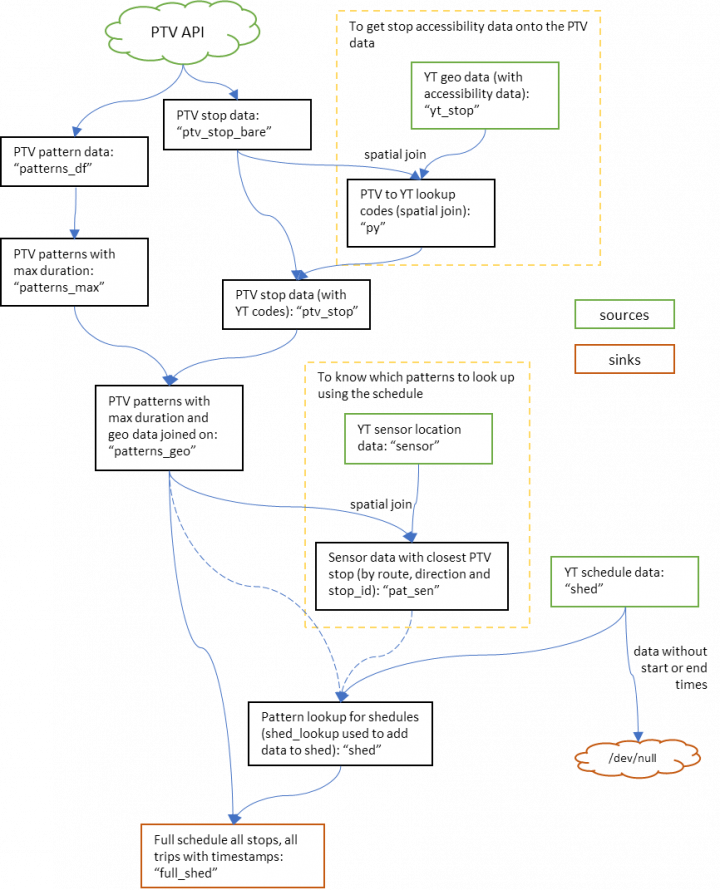
Source: VAGO.
Proximity of population to tram stops
Population data from the 2016 ABS Census at the SA1 level as well as tram stop location and accessibility data was used to calculate the resident population:
- within 500 metres of any level-access stop
- within 500 metres of any regular stop (but not within 500 metres of any level access stop)
- not within 500 metres of any tram stop.
Each SA1 was associated with its nearest tram stop (by distance to the centre of the SA1) and classified according to the scheme above. These populations were then totalled according to this classification.
Results from this analysis can be found in Section 2.3, Figure 2O of the report.
